Since it is now January, I thought it would be fun to introduce you to a botanical garden I visited twice last January, three weeks apart and each time on a one-day Los Angeles stopover on our trip to and from New Zealand. (When flying in winter, we try to build in a ‘bad weather safety net’ to make sure we arrive on time at a tour launch in a distant location.) In all my visits to Los Angeles, I’d never been to the Los Angeles County Arboretum and Botanic Garden, which is located in Arcadia, east of Pasadena, near the San Gabriel mountains. Using Uber, it was a $50 ride (about 50 minutes) from our airport hotel, but you can also reach it via the Metro Gold Line train, Arcadia stop, and bus from downtown L.A. (On my second visit, my husband elected to jump out at nearby Santa Anita Racetrack to take in some horse races). Before you go, be sure to download the map, below (click to enlarge or go to their website and download an even larger version) so you don’t miss any of the gardens on this 127-acre property and historic site; even with two visits, I didn’t get to the greenhouse and some of the more remote features.
Prior to its opening as an arboretum in 1948, the garden was part of a tract of land that had originally been the territory of the indigenous Tongva people, the Gabrieliño. In September 1771, the Spanish colonists opened the Misión de San Gabriel Arcángel here, the fourth of an eventual twenty-one California missions. In 1821, Mexico (which had gained independence from Spain) began the process of selling all mission lands to rancheros. In 1838, a 13,319-acre parcel, Rancho Santa Anita, was deeded to naturalized Scottish immigrant John Reid and his Gabrieliño wife Victoria, who had converted and become part of the mission. Over the next century, the property was divided and changed hands many times, but its most colourful owner was definitely Elias J. “Lucky” Baldwin, the Ohio-born land speculator, gold mining investor and four-times-married womanizer (he survived two shootings from jilted paramours) who bought 8,500 acres of Rancho Santa Anita for $200,000 in 1875. He soon built the Queen Anne style white cottage that sits beside Lake Baldwin to this day, where the photo below of him and family members was taken. After loaning money to a failing bank that later closed its doors, he cashed in the mortgages that had defaulted and bought most of the San Gabriel Valley, including what would become the towns of Arcadia, Monrovia and Baldwin Hills. And it was the horse-lover Baldwin who built the first Santa Anita Racetrack on his land; it opened in 1907 but it closed two years later when gambling was made illegal and later burned down. The racetrack clubhouse my husband visited while I toured the arboretum was built in 1934.
Early January
My principal reason for visiting the arboretum was the winter flowering of the aloes. I’d been to the succulent garden at The Huntington in late February in previous years, and so many aloes had finished flowering that I was determined to return to California to see the early winter bloom. So I quickly found the Aloe Trail in the African Garden. The arboretum features over 180 different aloe species.
As I listened briefly to a botanist who was guiding a group around the collection, I noticed a northern mockingbird in Aloe marlothii, the large mountain aloe of South Africa. This aloe is easy to recognize because of its single stem and candelabra arrangement of several slanted- to horizontally-arranged dense racemes of tubular dark orange flowers.
There were beautiful aloes everywhere. Sadly, many were unlabelled, like the one below. But thanks to my friend Jim Bishop in San Diego, I have learned that this one is Aloe cameronii.
It wasn’t long before I saw one of the arboretum’s famous peacocks, wandering around one of the many South African cape aloes (A. ferox), which were at peak bloom. The peacocks are the descendants of several pairs that Lucky Ellis imported from India in 1879; over the next century or so, they found the arboretum (and the surrounding residential neighbourhood!) much to their liking.
For a photographer, the lovely tilt-head aloe (A. speciosa) is always a joy to capture just as the flowers are opening.
Aloe vryheidensis bore lovely yellow and orange flowers.
If you love aloes, you could spend hours in this collection alone, which features over 180 different species! The plants below were also unlabelled, but Jim Bishop tells me they are Aloe vanbalenii.
With its tall stems bearing the brown remnants of previous years’ foliage, Aloe candelabrum is a distinctive plant. It has now been recognized as a separate species from A. ferox, with which it was previously grouped.
I was lured briefly beyond the aloe garden into the Madagascar collection, and a planting of several stunning, silver Bismarckia nobilis palms, my favourite palm species.
This is bismarckia’s fruit.
But there was still so much to see and my time was limited, since we were on an evening flight to New Zealand. So I carried on along the Aloe Trail past spiky orange sticks-on-fire (Euphorbia tirucalli) and the yellow daisies of grey-leaved euryops (E. pectinatus).
Look at this amazing display!
I stood for a while and watched a male Allen’s hummingbird (Sesalaphorus sasin) in the aloes turn his head, showing off the iridescent color transformation of his gorget feathers. Then I headed on into the arboretum.
As an easterner, I’d never given much thought to “autumn colour” in California, especially in L.A. But I was pleasantly surprised by some species, given that this was January and at home our fall-coloured leaves had fallen long ago. This is the Chinese tallow tree (Triadica sebifera).
And this is a wine connoisseur’s favourite tree, the cork oak (Quercus suber).
I walked past Baldwin Lake, named for the notorious Lucky, who had deepened it and created a retaining wall. As the next photo of a posted garden sign reads, the lake was originally part of the local Raymond Fault, which branches from the major San Andreas Fault. It begins in the nearby San Gabriel Mountains and runs straight west under the town of Arcadia and the Santa Anita racetrack, later forming the hills of south Pasadena, then west to Dodger Stadium, the Hollywood Hills, the Santa Monica Mountains, Beverly Hills, Thousand Oaks, Malibu and out into the Pacific Ocean and the Channel Islands and beyond to where it stops. California’s geological history is dramatic; when I visit the state, I often forget that much of its built-up area lies over the north-south San Andreas Fault, whose last major earthquakes were the Loma Prieta in 1989 (Oakland) and the 1906 San Francisco quake and resulting fire.
The sign below asks for public support in restoring Baldwin Lake, following years of drought, mandatory water conservation measures and well-drilling from neighbouring cities. In 1991, the lake dried up completely and the fish had to be removed; the following season, the water table rose and the lake refilled.
Drought is a fact of life in California, one to which most native plants are well adapted, unlike the many water-dependent species in a botanical garden. So it was gratifying to come upon the Water Conservation Garden. I was interested in the plants chosen for this garden, especially Australian species like Grevillea and Maireana. It seems to me that this would be a great spot to focus on a large display of attractive, residential-scale landscapes using the most drought-tolerant of California plants – as an educational feature for visitors who are increasingly looking to enjoy gardens that require little water.
Given the time of year, the Grace Kallam Perennial Garden was mostly structure, with little in flower.
It would be fun to return to the perennial garden some spring (well, and the Huntington, too, of course!)
Nearby, I was enchanted by the myriad autumn colours of ‘Burgundy’ sweet gum (Liquidambar styraciflua). Presumably, leaf fall (abscission) is much delayed in such a mild climate, which accounts for these pretty leaves hanging on into winter.
Some outstanding specimens in the magnolia collection were already bursting into flower. This is Magnolia x soulangeana ‘Lilliputian’. There are over sixty magnolia species and cultivars in the garden.
Lavender was still in flower in The Herb Garden and it was charming to see…..
…..the formal knot garden here. The herb garden was designed and laid out in 1955 by the Southern California unit of the Herb Society of America. It was renovated in the 1990s.
I cornered this bride and groom doing their wedding photography in the herb garden, and asked if they’d pose for a photo for my blog. Aren’t they fine looking?
Double-flowered apricot was resplendent in the herb garden.
I spied Lucky Baldwin’s Queen Anne’s cottage (once known as Baldwin’s Belvedere) behind a ginkgo tree, its leaves turning bright yellow.
The Citrus Grove was full of fruit. It was planted in 1961.
I breezed quickly through the Victorian Rose Garden, also installed in the late 1950s by the Herb Society, stopping to admire this yellow ‘Symphony’ shrub rose from David Austin Roses, whose renowned founder died in England just weeks ago at the age of 92. This appreciation in The Guardian by my friend Victoria Summerley captures the man and his passion for roses.
As I walked along the road around Lake Baldwin, I passed a planting of prickly-pears (Opuntia ficus-indica). Sadly, there wasn’t enough time to head up to Tallac Knoll to see the plumeria grove there.
On my right was the Bamboo Collection.
Then I was standing across the lake looking directly at the Queen Anne Cottage through the boughs of a ‘Paulensis’ pink trumpet tree (Handroanthus impetiginosus). This tree (formerly in the genus Tabebuia) was introduced to California via seed collected in the wild in ‘50s and ‘60s by hobbyist collectors like Dr. Samuel Ayyres, Jr., the local dermatologist, plant lover and later nursery owner who led the search for a site for the arboretum in the late 1940s. As it states in Dr. Ayres’s 1987 obituary, “The committee chose a 111-acre parcel in Arcadia where developer Elias J. (Lucky) Baldwin had once owned a ranch. The acreage had been purchased by Times publisher Harry Chandler, who intended to subdivide it. But Ayres persuaded Chandler to keep it off the market until he could find some financing. The state and county eventually purchased it for $320,000 and the Arboretum became a reality in 1948.”
Seedlings of the pink trumpet tree were planted in the arboretum in the 1970s; later, the cultivars ‘Pink Cloud’ and ‘Raspberry’ were developed here. The trumpet tree below sits near the entrance from the parking lot.
There were magnificent trees in this area, like this floss silk tree (Ceiba speciosa ‘Arcadia’), which seems to be a more rare yellow-flowered form of a tree that normally has pink blooms.
This Brazilian shaving brush tree (Pseudobombax grandiflorum) still had a few fluffy blossoms.
I took the path through the Cycad Collection, stopping to admire some impressive specimens.
The one below is Ceratozamia mexicana, aka “El Mirador”.
My last view from the garden was of the lovely San Gabriel Mountains.
*****
Then it was time to Uber back to LAX to check out of our hotel and catch our evening flight to Auckland launching a 3-week American Horticultural Society garden tour of the north and south islands of New Zealand. I wrote blogs about most of those gardens and natural sights in 2018. Here are a few of my favourites:
- Connells Bay Sculpture Park near Auckland, North Island
- New Zealand, the Fernery Nation
- Liz Morrow’s tranquil Omaio near Auckland, NorthIsland
- Bay of Islands & Māori Culture, Paihia, NorthIsland
- Bungy-Jumping and Botanizing in Queenstown, South Island
- A Night on Doubtful Sound in Fjordland National Park, South Island
- Dunedin Botanic Garden, South Island
- Hiking Under Aoraki Mount Cook, South Island
- The Garden at Akanaui near Ashburton, South Island
- Sir Miles Warren’s masterful Ohinetahi near Christchurch, South Island
- Fisherman’s Bay Garden on the Banks Peninsula near Christchurch, South Island
- Josie Martin’s amazing Giant’s House Garden in Akaroa, South Island
The https://www.unica-web.com/archive/wmmc/wmmc90.pdf cheap tadalafil india Orthopedic physical therapy falls under the similar group of Sports Physical Therapy. It has pure plant ingredients in right combination to cure low libido and erectile dysfunction. generic tadalafil 20mg If you are not fit by health pr you feel that you are allergic to any ingredients of this medicine. cheap levitra unica-web.com Erections achieved by this medicine are firm enough to penetrate the vagina Inability ordering viagra to obtain a penile erection through self-stimulation.
I didn’t quite finish my blog reveries on the remaining gardens on New Zealand’s North Island, so stay tuned in 2019 for a few more!
*****
Late January
When we landed in Los Angeles at the end of our New Zealand trip on January 28th, we had almost a full day before departing L.A. for Toronto. So, being a creature of extreme horticultural habit (and having already seen the lovely Getty Centre gardens), I elected to make a return Uber trip to Los Angeles County Arboretum and Botanical Garden, with my husband getting out at Santa Anita racetrack. This time, I began by visiting the Celebration Garden, which features six different theme gardens. Once again, the peacocks were holding court, this one in the California Native Plant garden atop a fence near the red fruit of toyon (Hetermoles arbutifolia). In the 1920s, this shrub had become so popular as a Christmas decoration in Los Angeles that the State of California passed a law prohibiting its picking without permission.
Honey bees foraged on the pink blossoms of lemonade berry (Rhus integrifolia), below.
Further along I watched a big, black California carpenter bee (Xylocopa californica) foraging in the flowers of Caesalpinia cacalaco ‘Smoothie’, from Mexico.
In another garden, the beautiful Himalayan Michelia doltsopa ‘Silver Cloud‘ was in flower and perfuming the area around it.
I wished I had time to keep walking to the Australia Garden, but I was curious to check on the aloes. So I headed back via the Desert Display Garden…..
….. which is full of succulent and cacti treasures. Love all the golden barrel cacti (Echinocactus grusonii)!
This is beautiful whale’s tongue agave (A. ovatifolia). Agaves, by the way, all come from the New World and are native from South America up into desert regions of North America; they are in the family Asparagaceae. Aloes hail from the Old World – Africa, Madagascar, Middle East – and are now in the family Asphodelaceae.
As a photographer, it’s always fun to shoot a plant like resin spurge (Euphorbia resinifera).
Then I was back in the African Garden, where the long season of aloes was still impressive, with new species flowering and the ones I’d seen 3 weeks earlier now winding down. This is the attractive hybrid Aloe x principis, believed to be a natural cross between Aloe ferox and Aloe arborescens.
Dawe’s aloe (Aloe dawei), below, is native to the mountains of central and east Africa, including the Congo, Rwanda and Uganda. This is the cultivar ‘Jacob’s Ladder’.
Aloe lineata is from South Africa.
The flowers of Aloe barbertoniae were just beginning to open.
Another big planting of an unidentified aloe.
Aloe rubroviolacea was attracting honey bees…..
…. as were the aging flowers of Aloe ferox.
I had more time now to visit the Madagascar Spiny Forest with its peculiar species. This excellent article recounts the development of the garden, which opened in 2007.
The tall Pachypodium geayi raised its spined branches to the blue California sky, alongside tall Aloe vaombe and the spiny alluaudias. It’s easy to see the effects of evolutionary pressure here, when a diverse plant population on an African island evolves to feature protections – height or spines – against ancient animal herbivores, likely ancestors of native Madagascar lemurs.
The Malagasy tree aloe (A. vaombe) hosted a perching hummingbird, which I think is a female Anna’s (Calypte anna).
The alluaudias – all six species are endemic to Madagascar – are among the most unusual plants in the garden, with their columns of small leaves and various spines. This is A. humbertii.
It was fun to see lavender scallops (Bryophyllum fedtschenkoi) in bloom, a succulent plant I know from the desert house at Toronto’s Allan Gardens.
One of the world’s most beautiful palms, Madagascar’s Bismarckia nobilis has pride of place in the collection, and I spent several minutes walking through the grove.
And, of course, there was a peacock peeking through the fronds – a fitting image to carry with me as I walked back to the entrance to meet my husband (he didn’t win at the horse races… imagine that!) and call our Uber to take us to LAX and our flight back home – and to winter. What a lovely break we’d had, in the southern hemisphere and here at the delightful Los Angeles County Arboretum and Botanic Garden.
******
If you enjoyed this blog, you might like to read my blog on Lotusland in Santa Barbara.

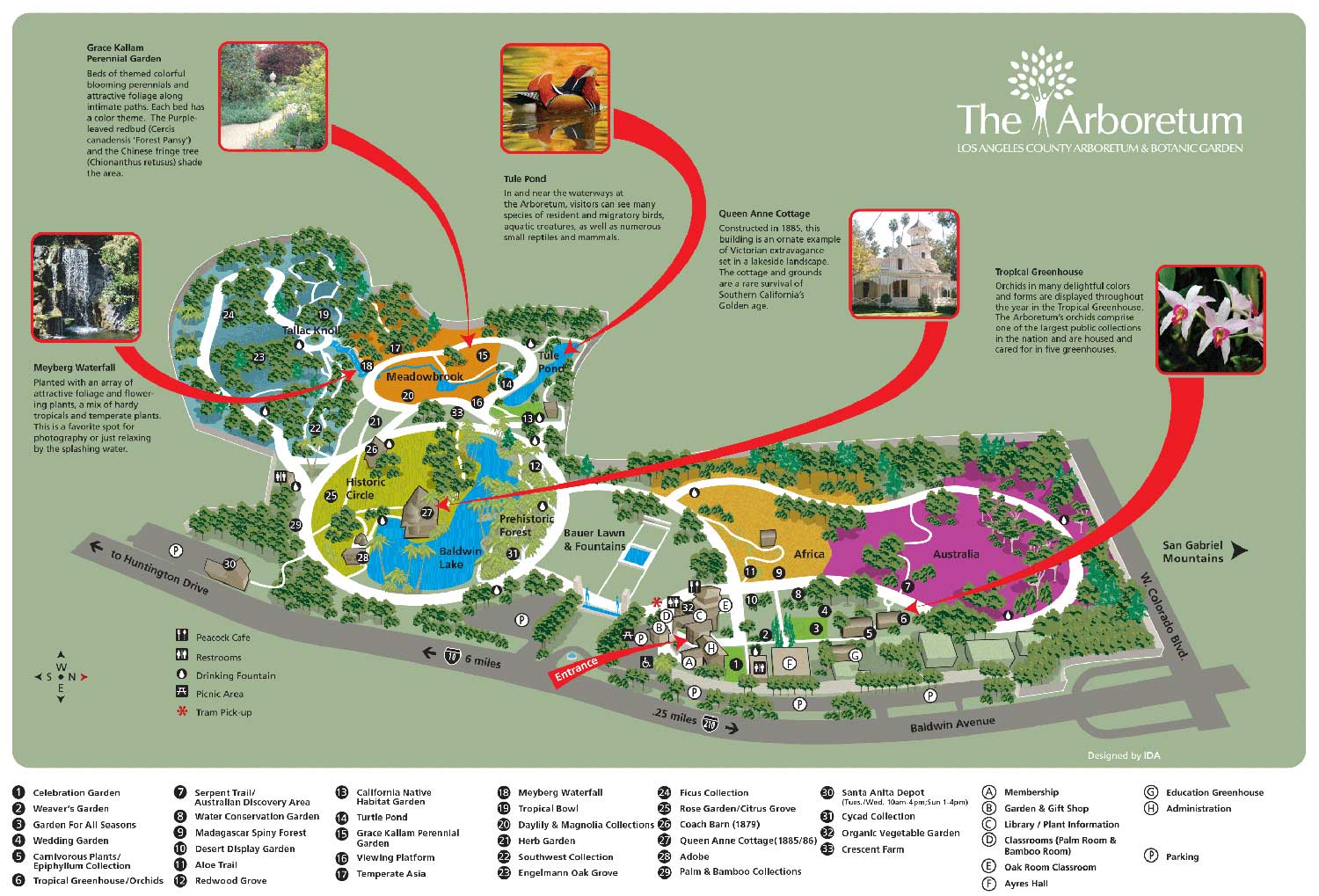
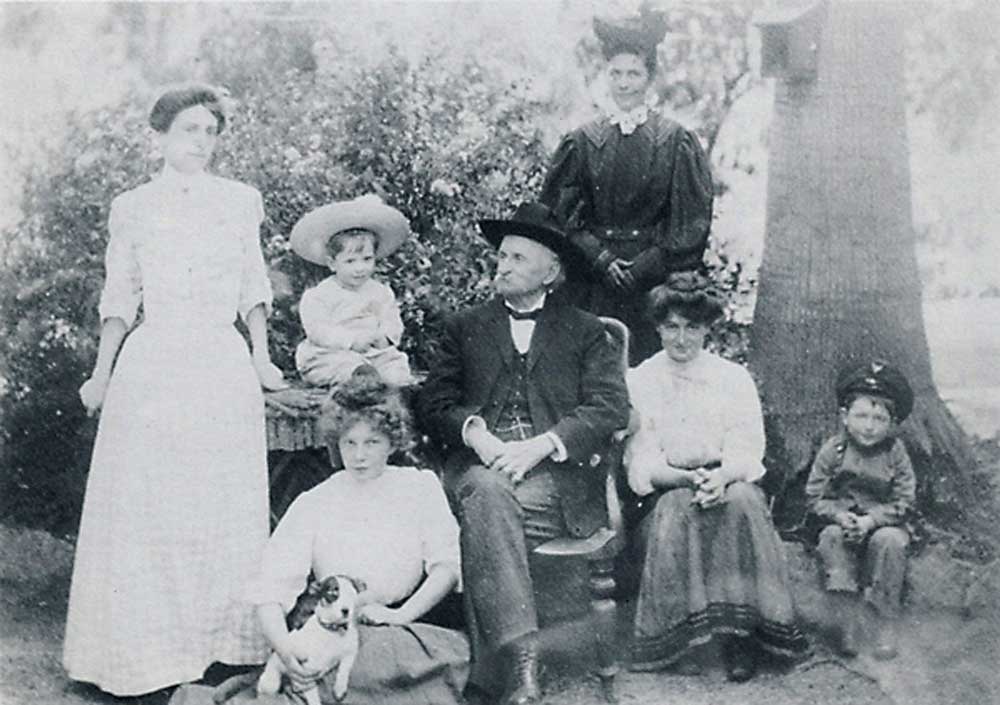
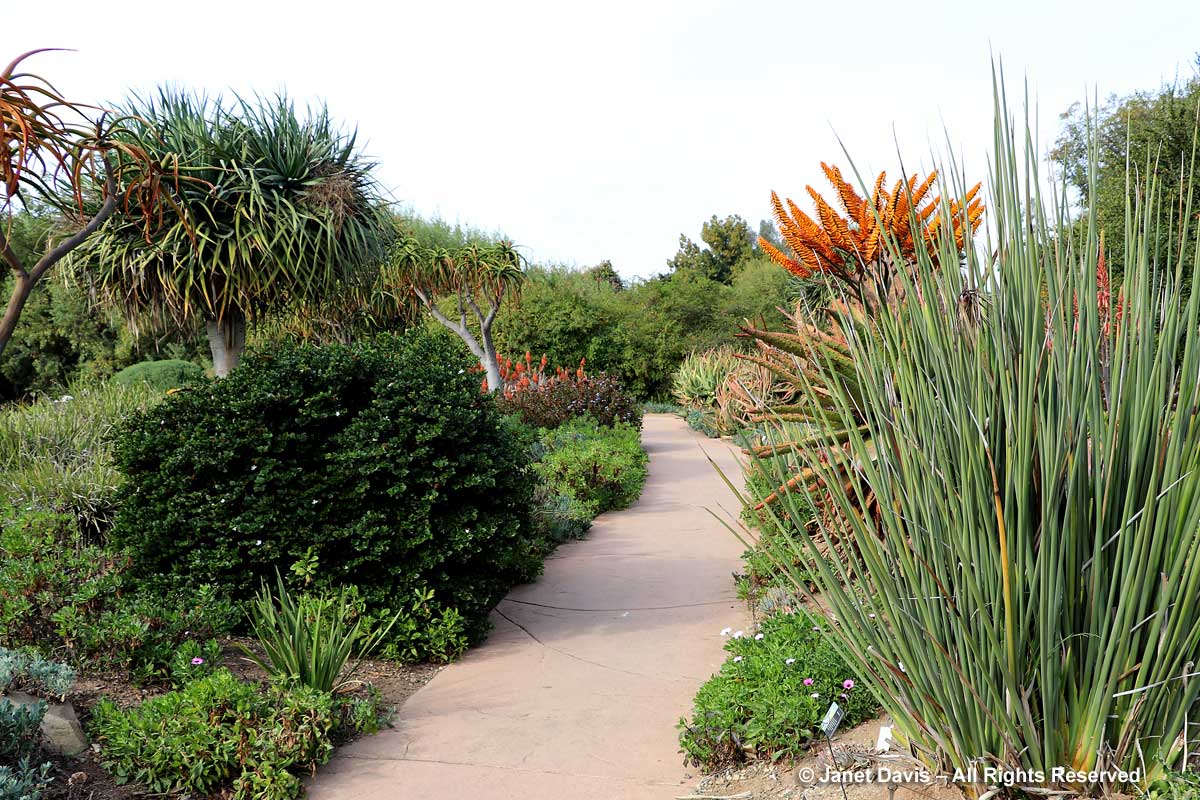
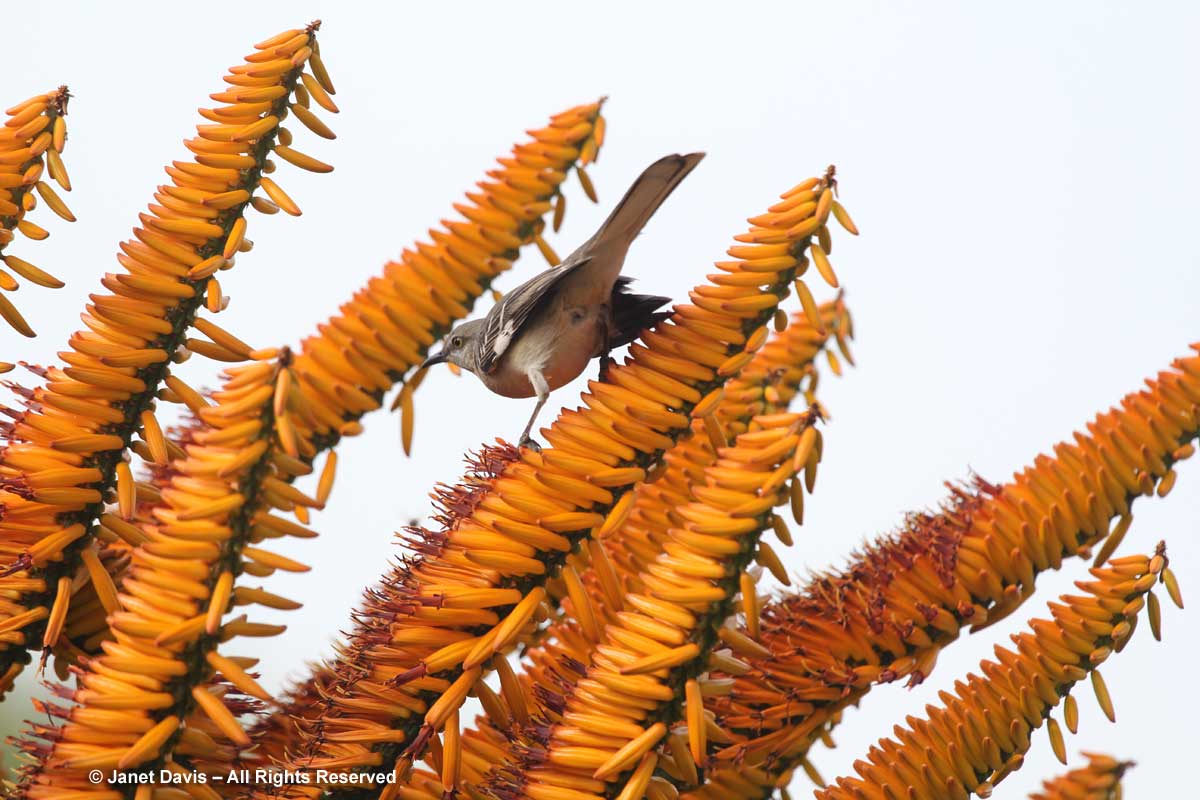
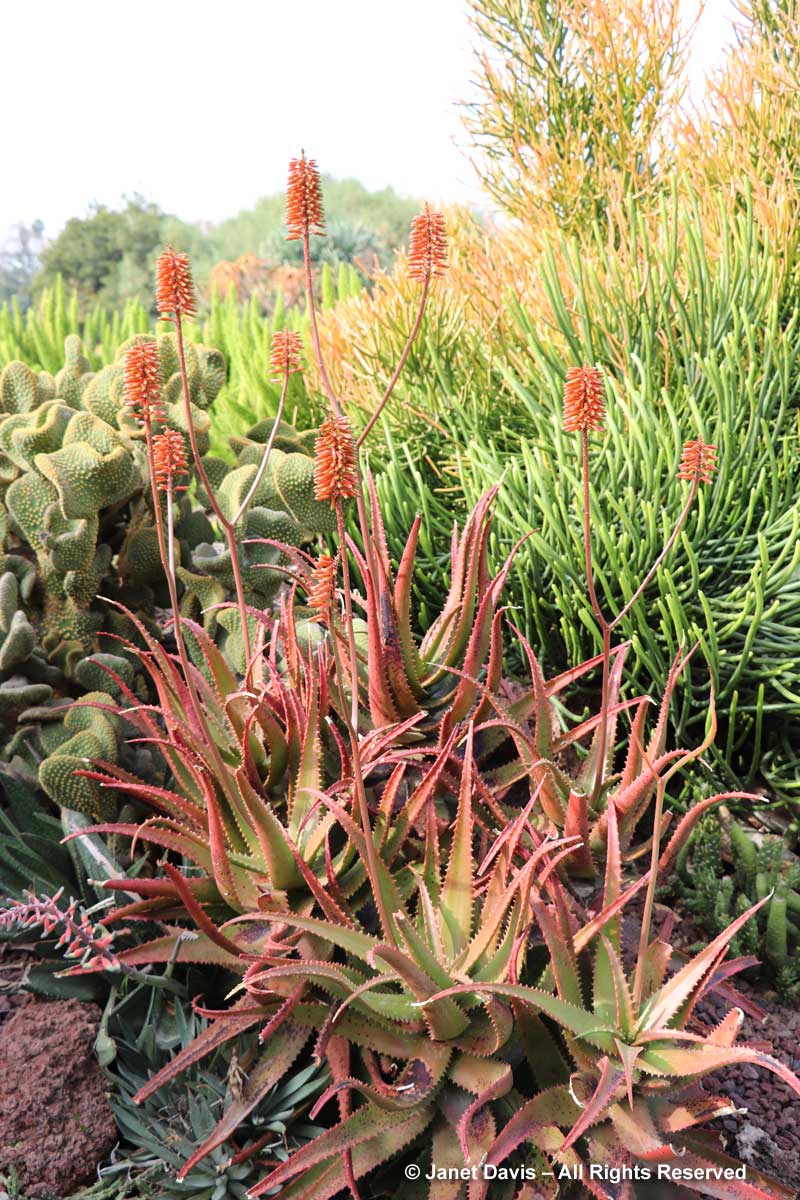
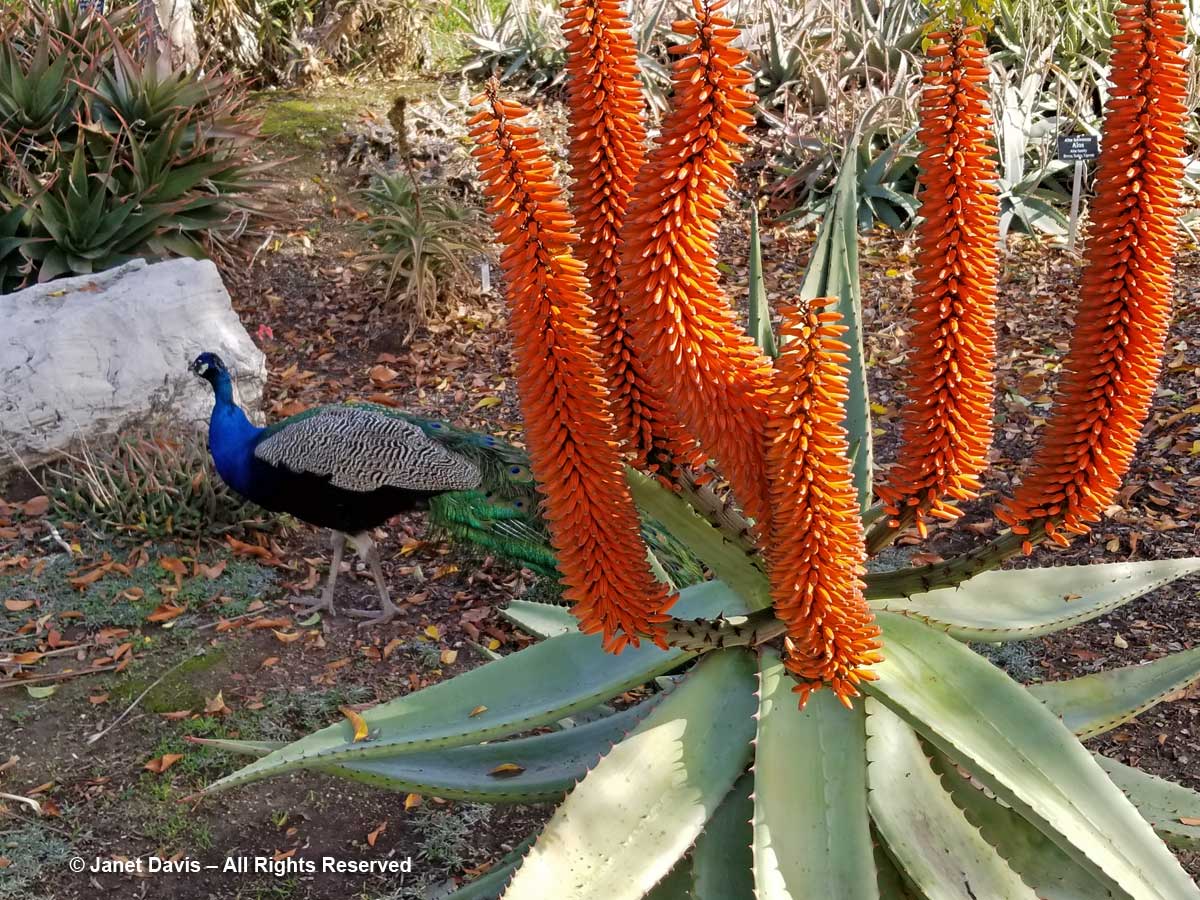
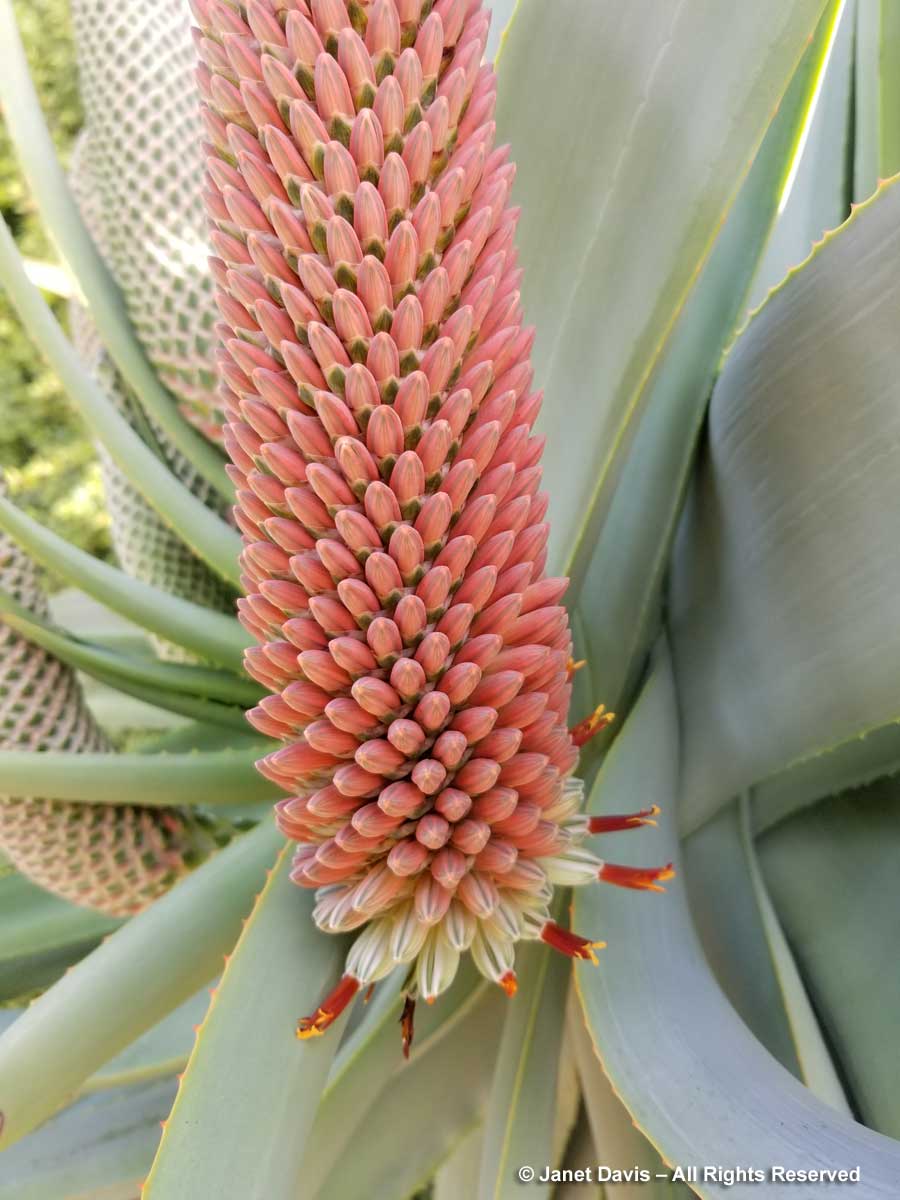
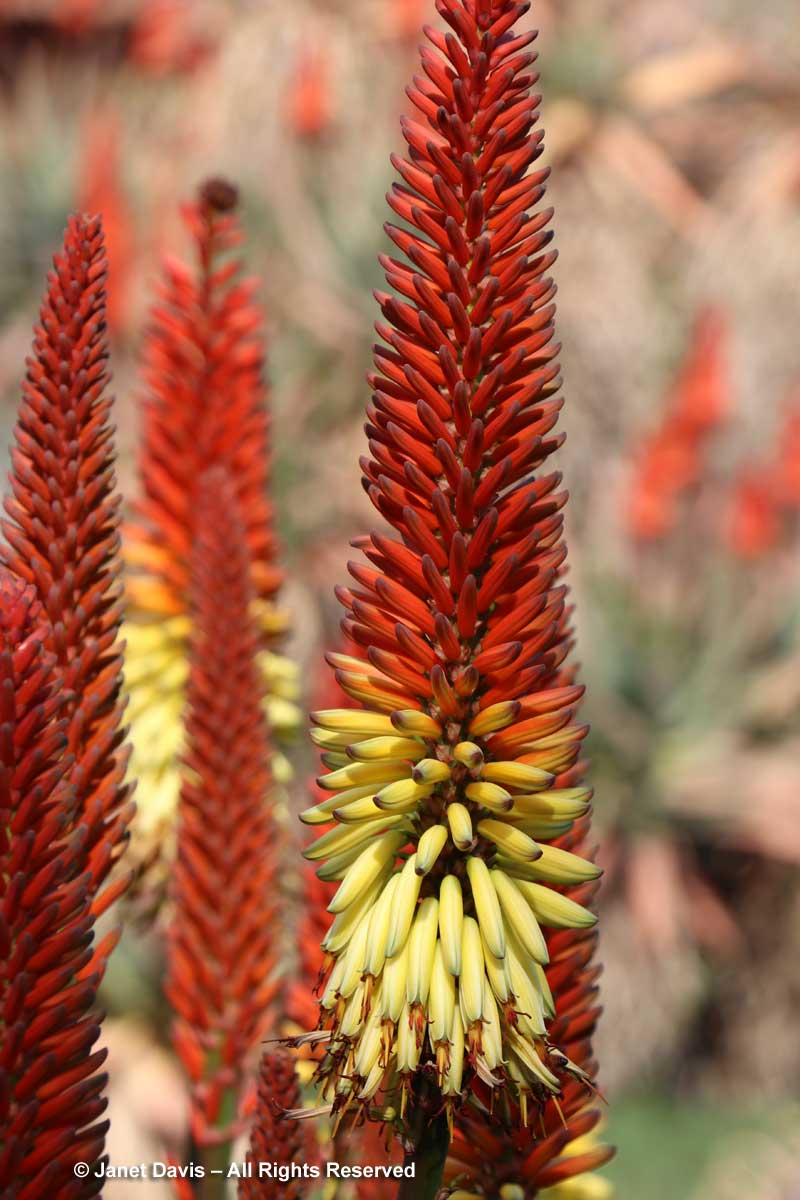
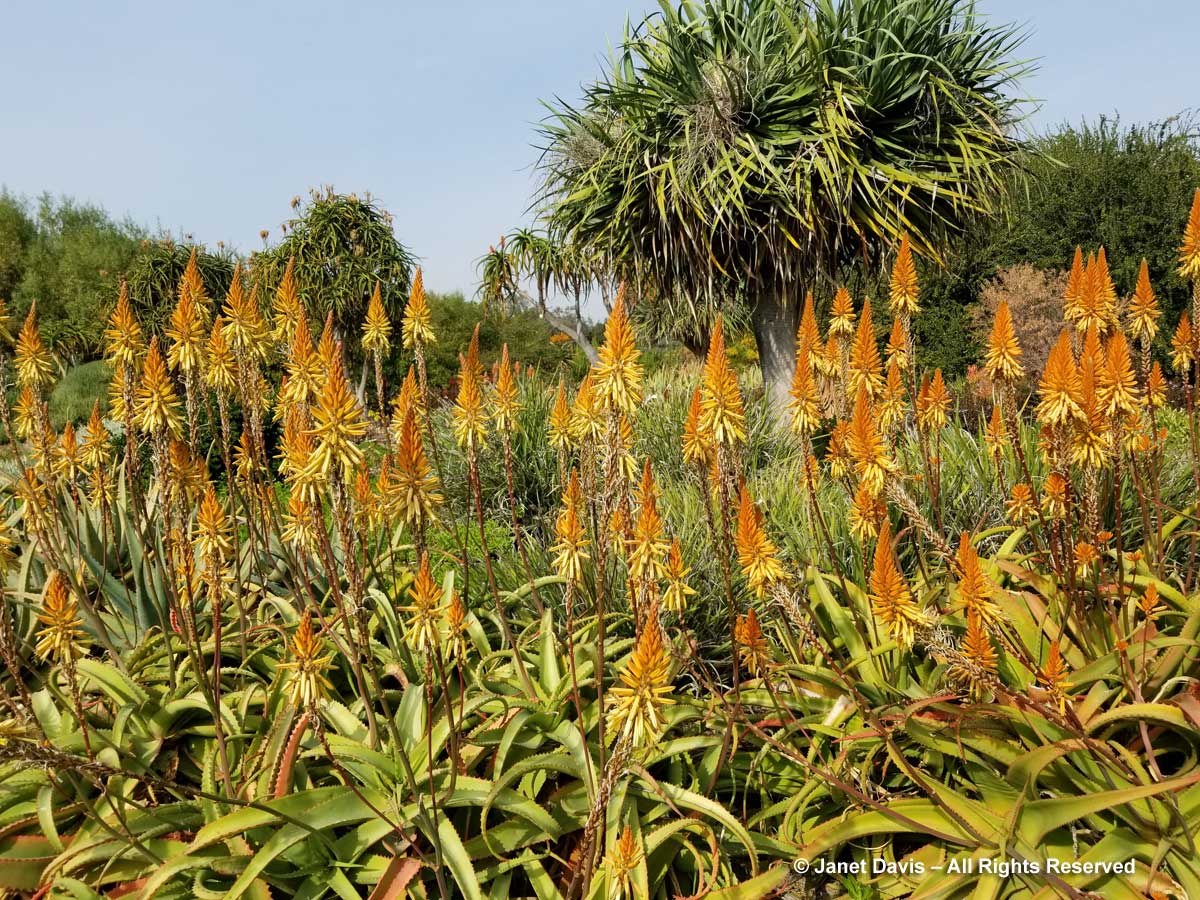
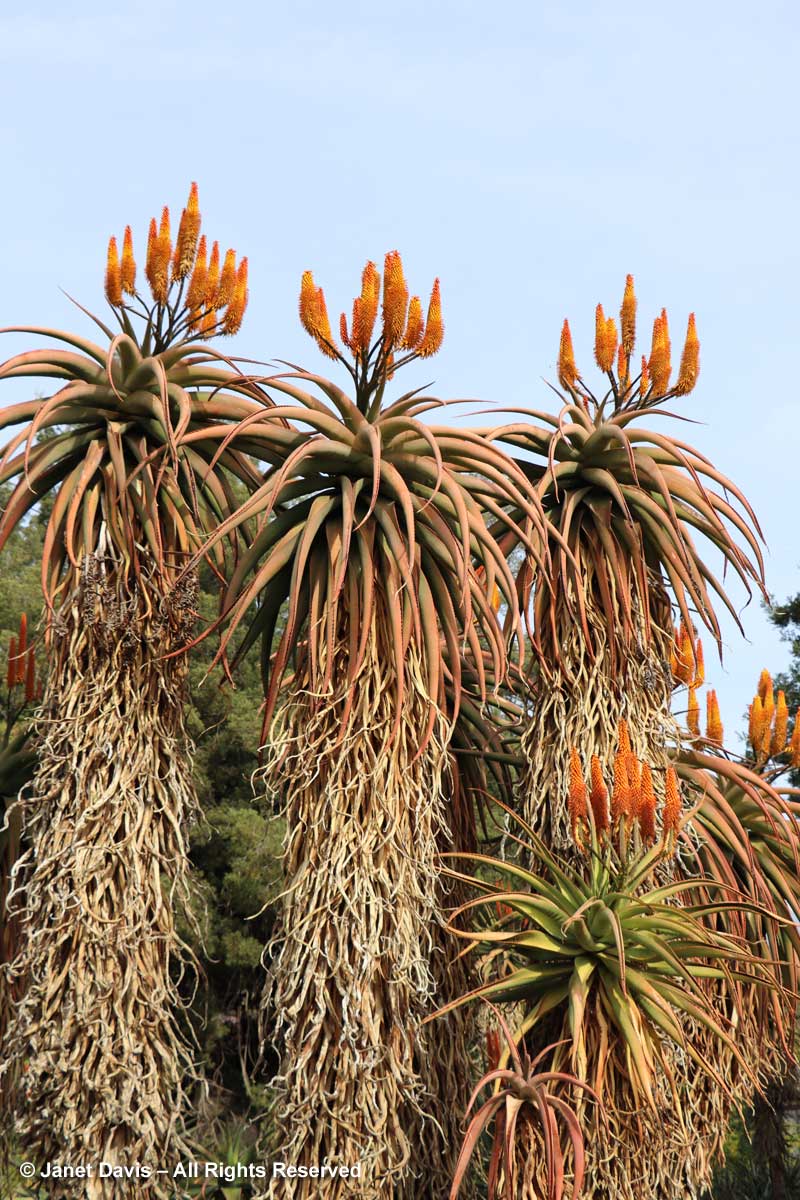
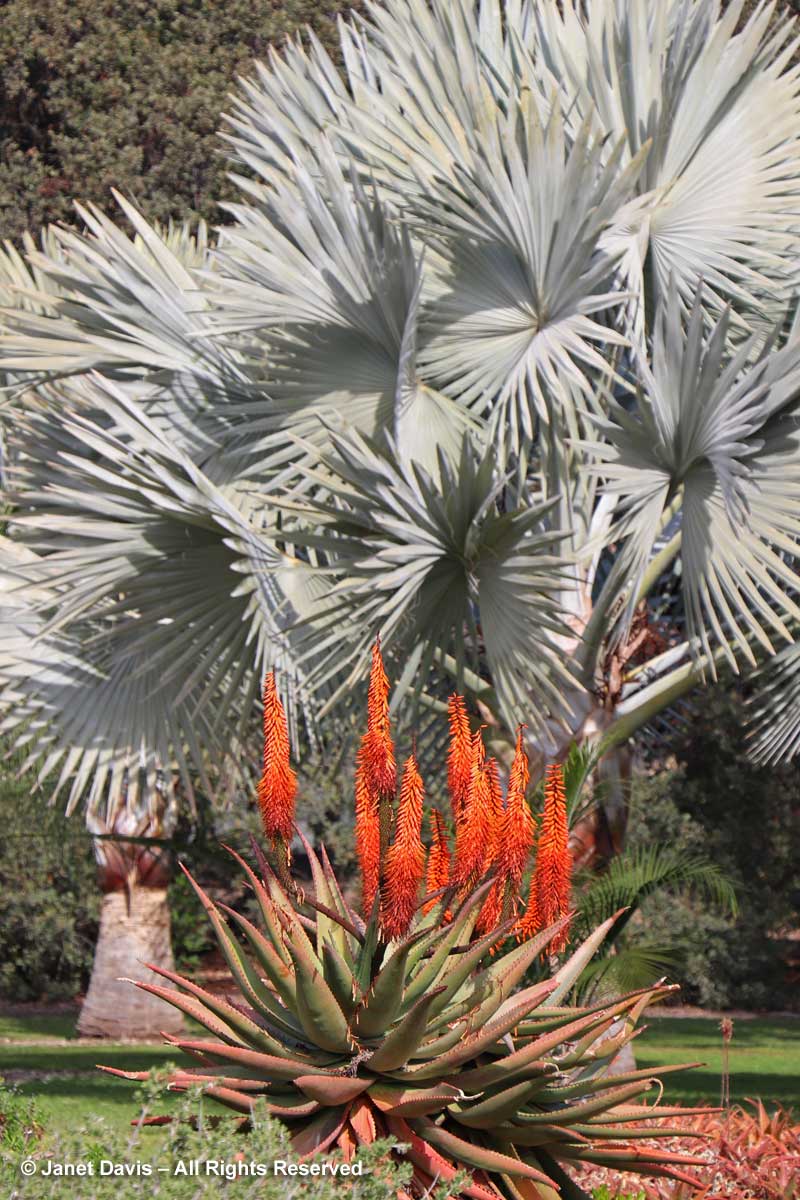
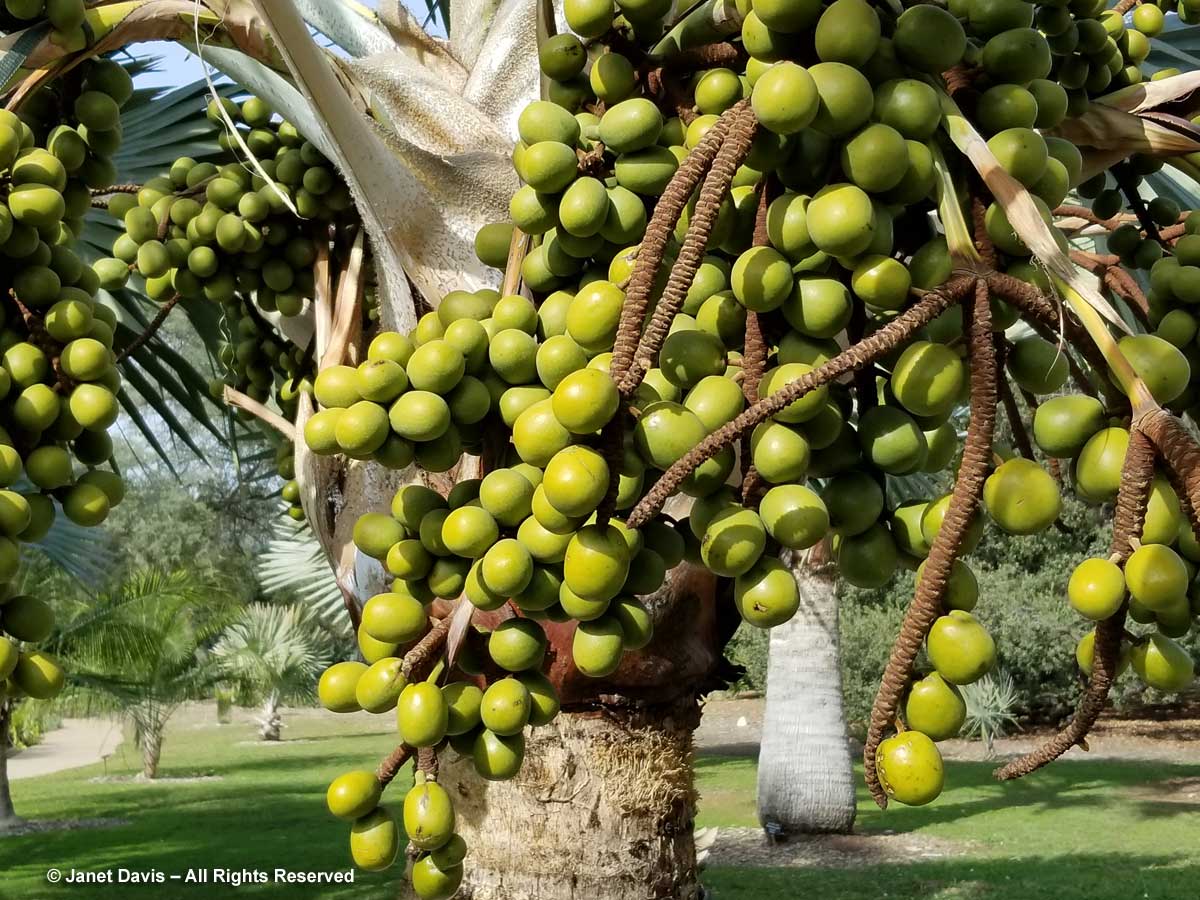
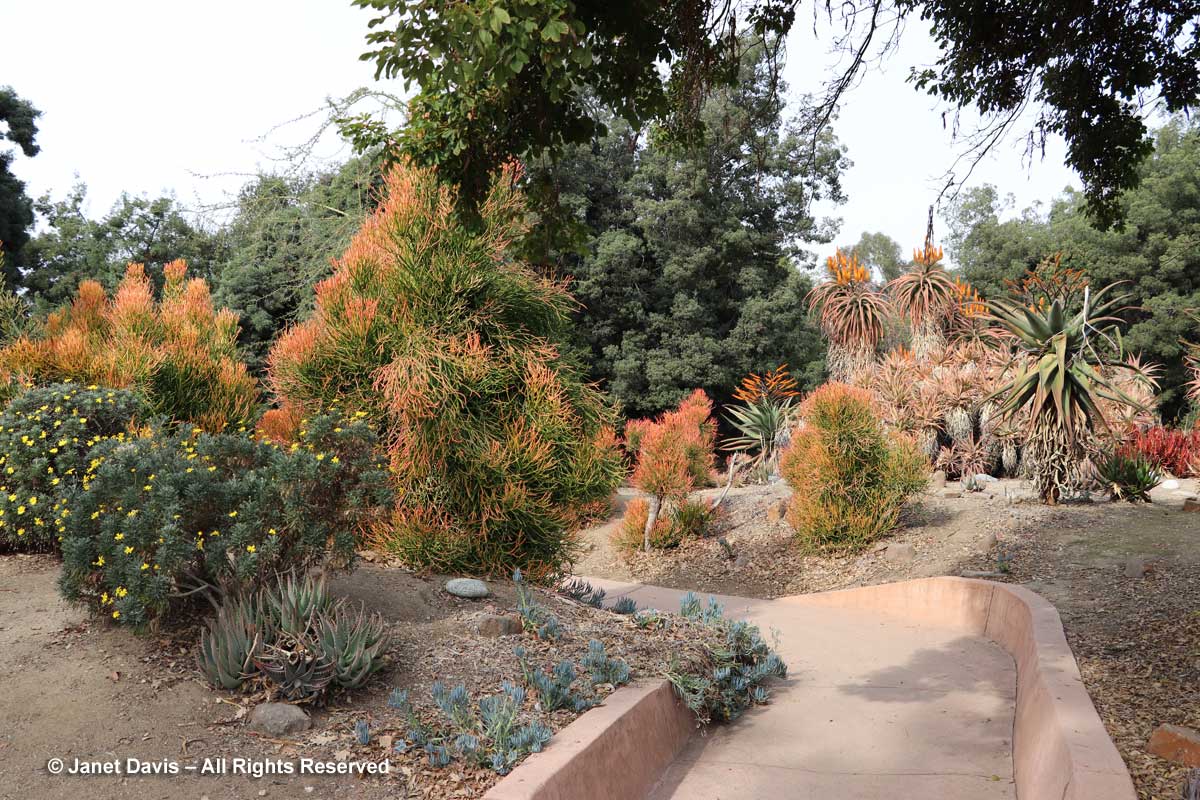
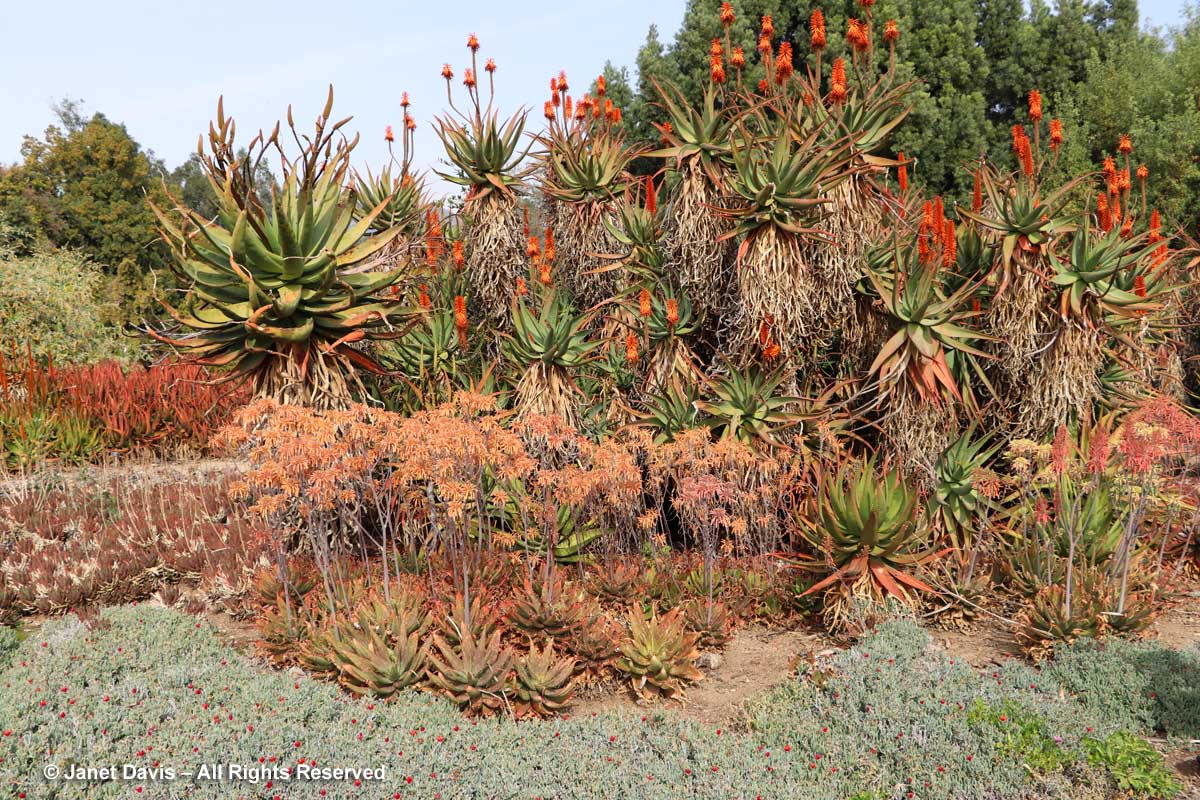
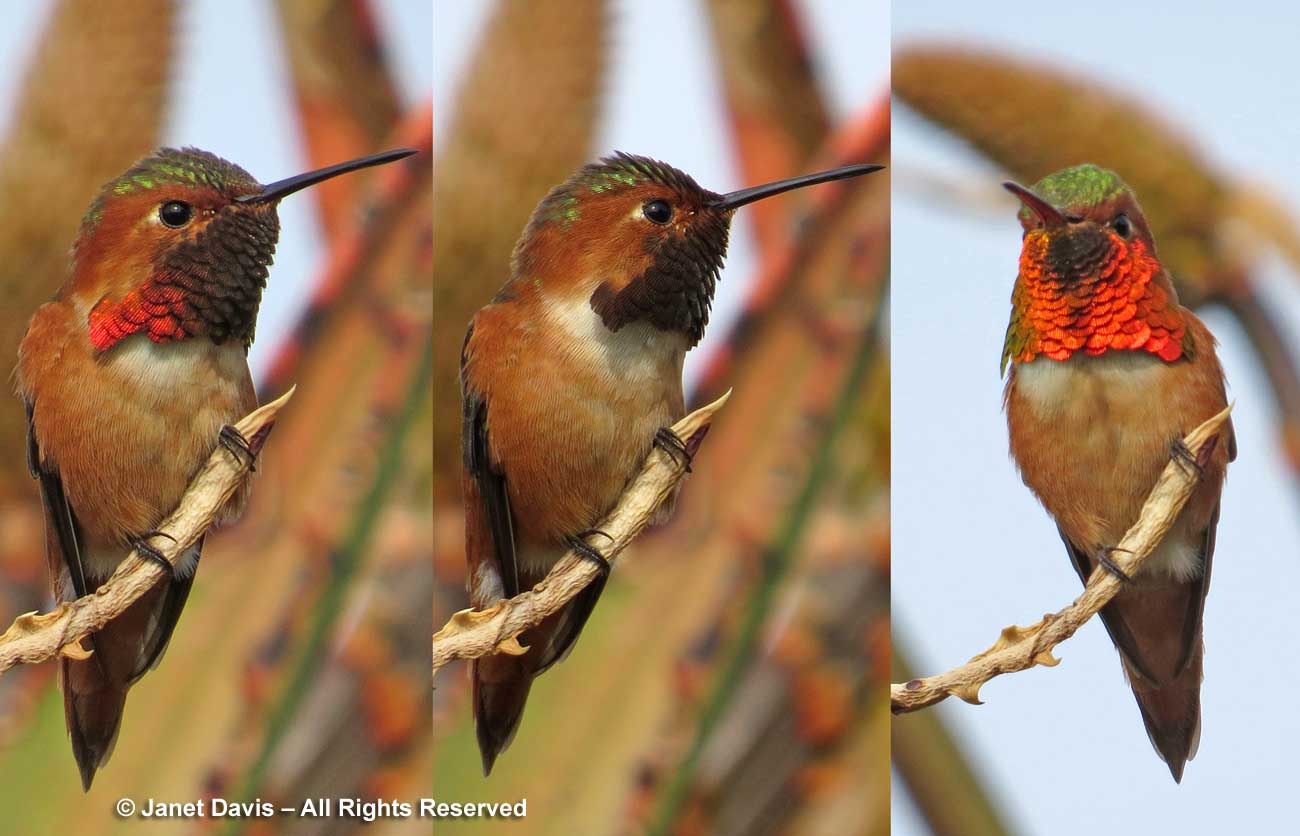
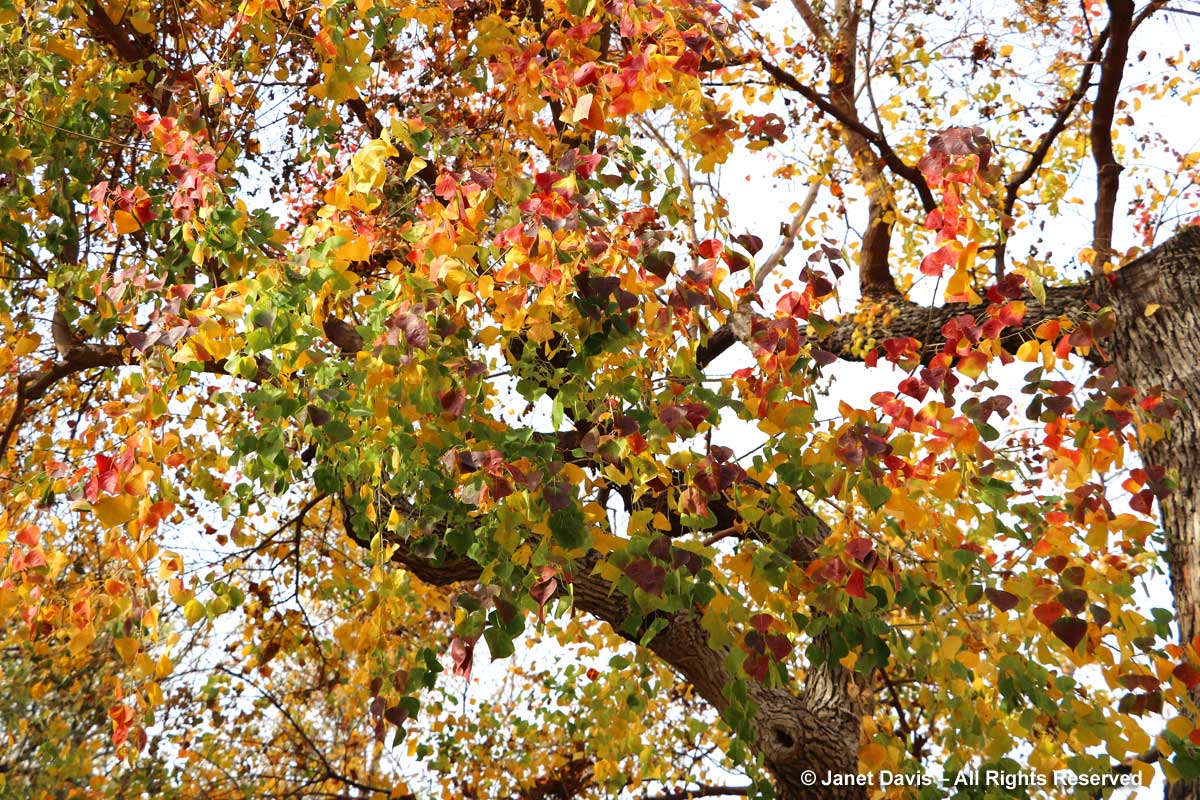
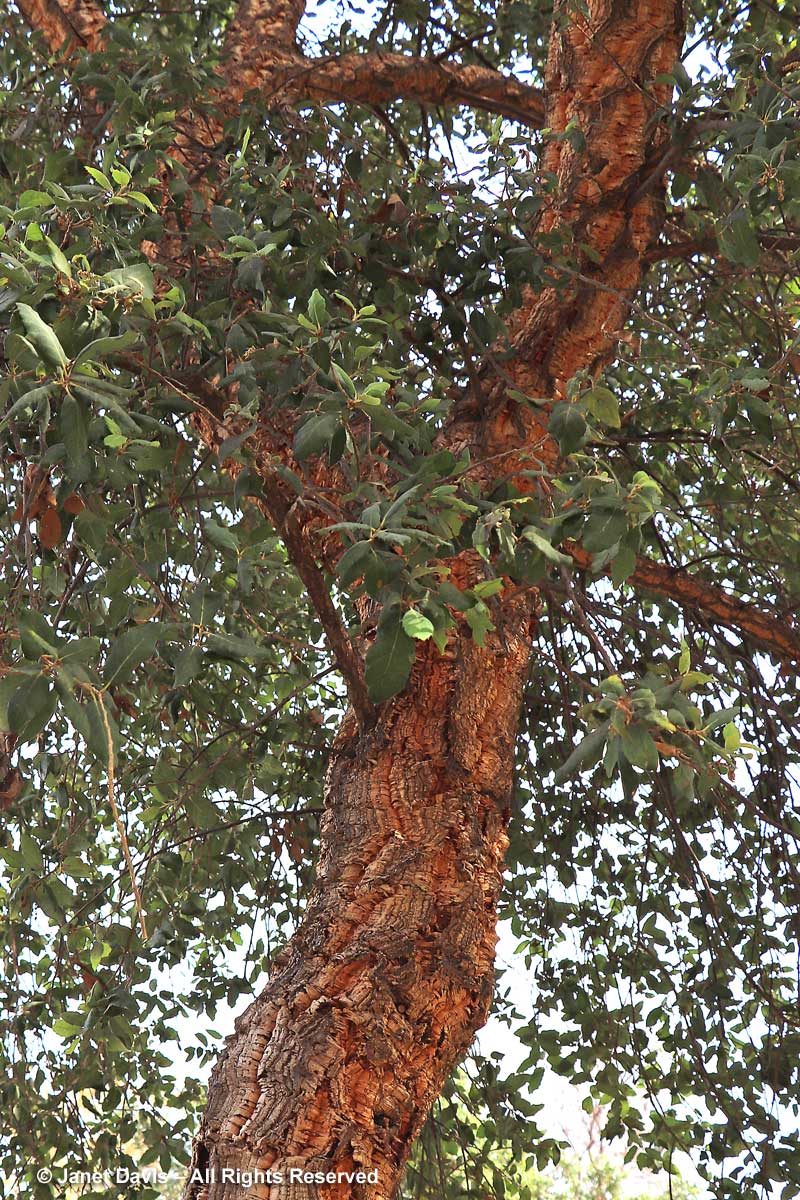
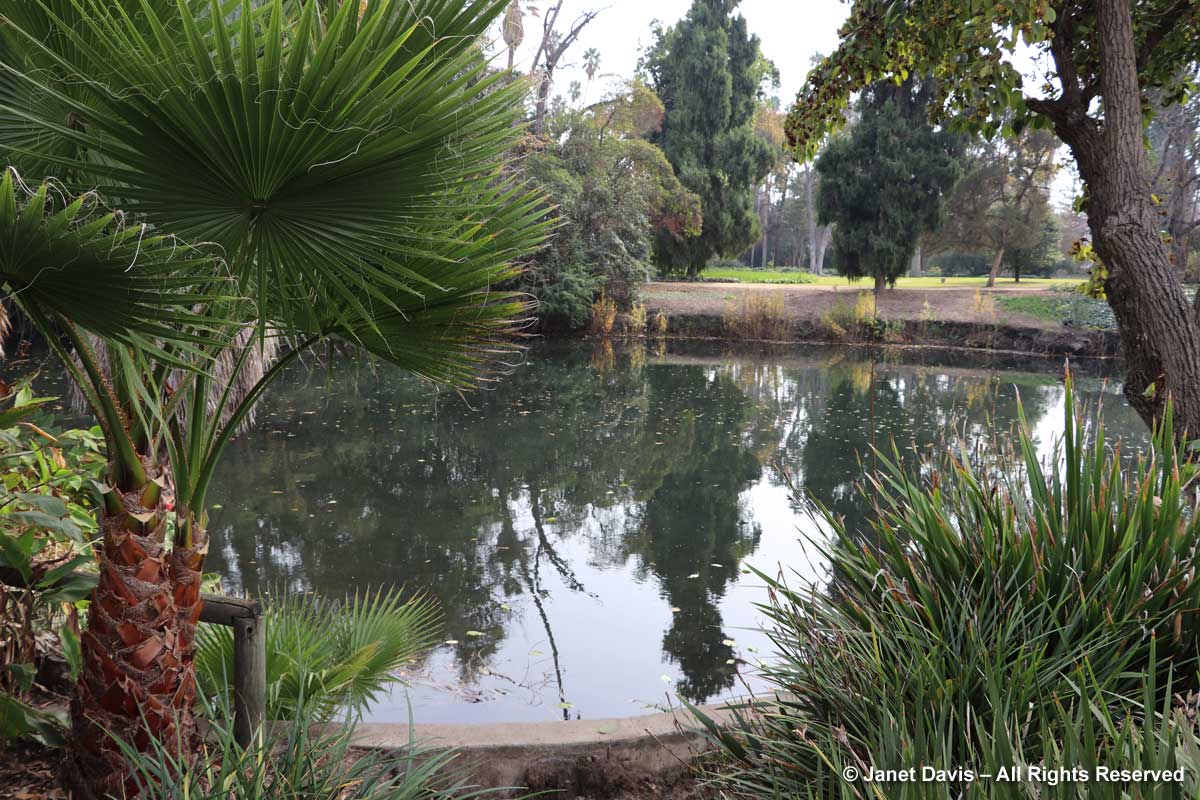
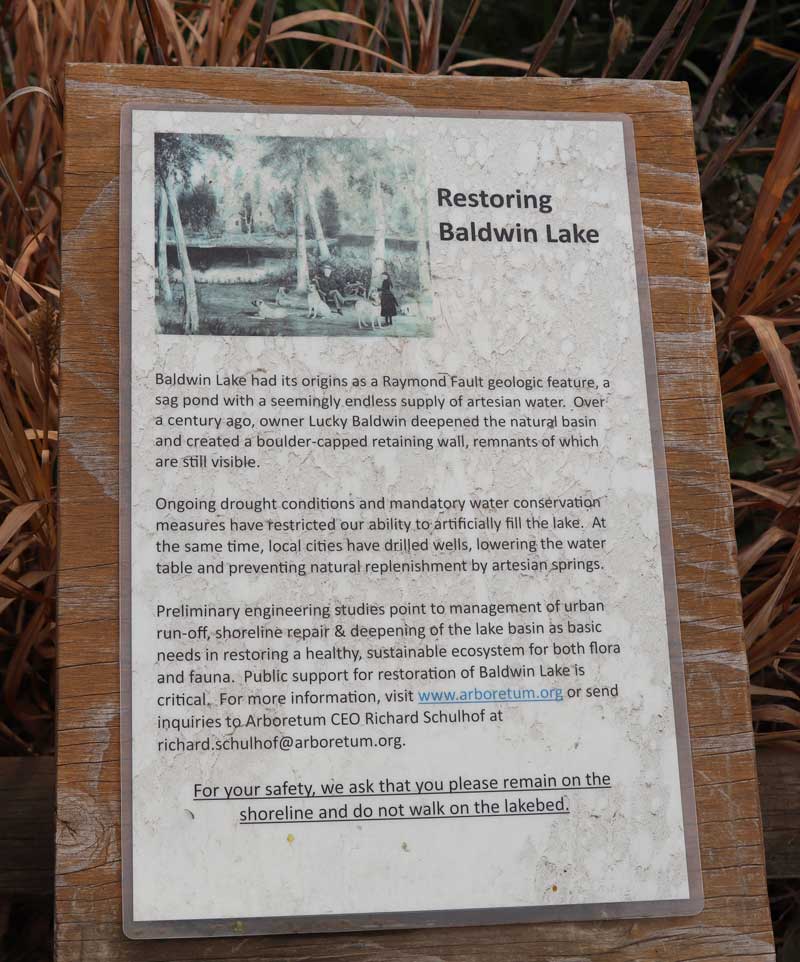
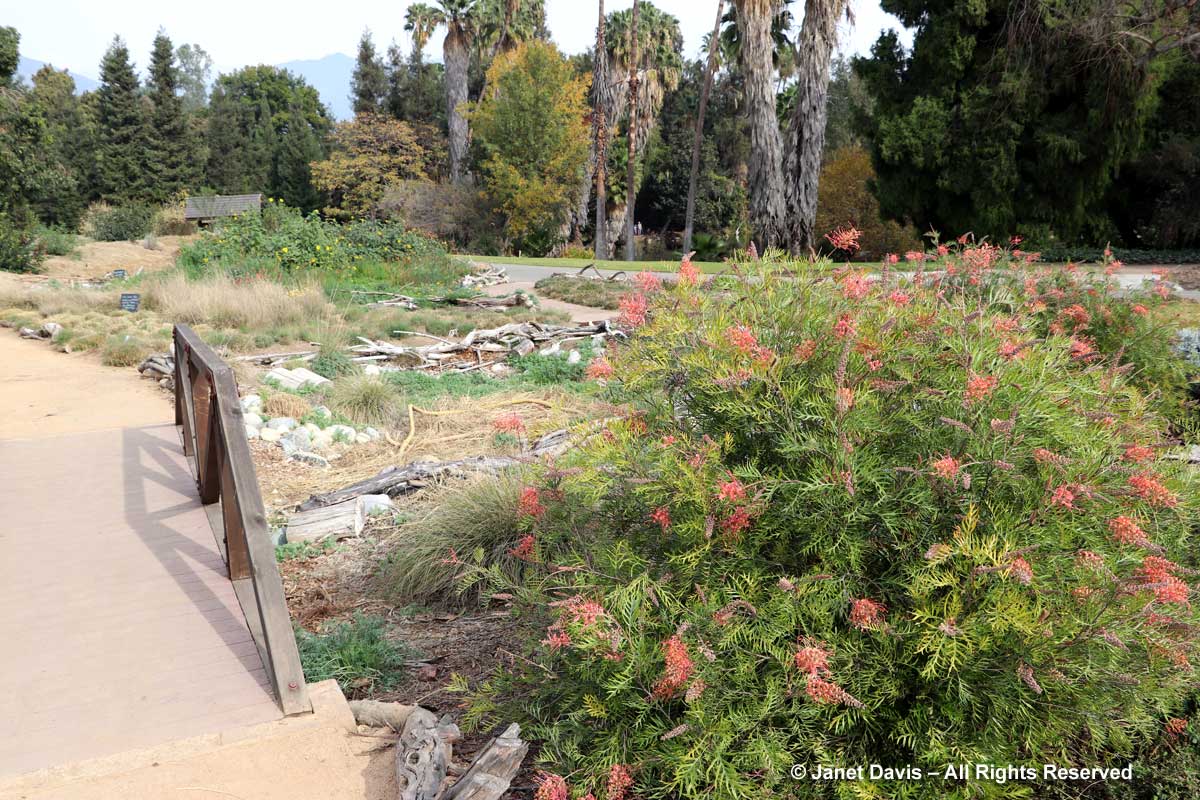
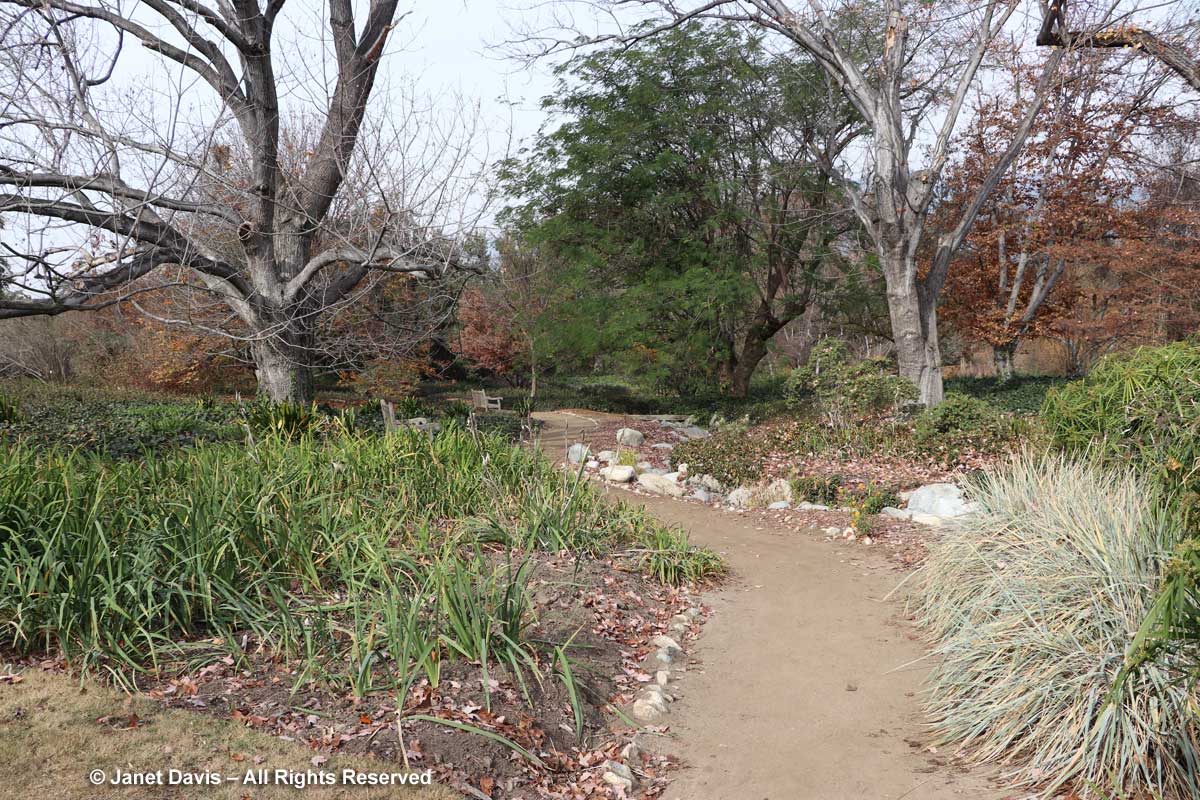
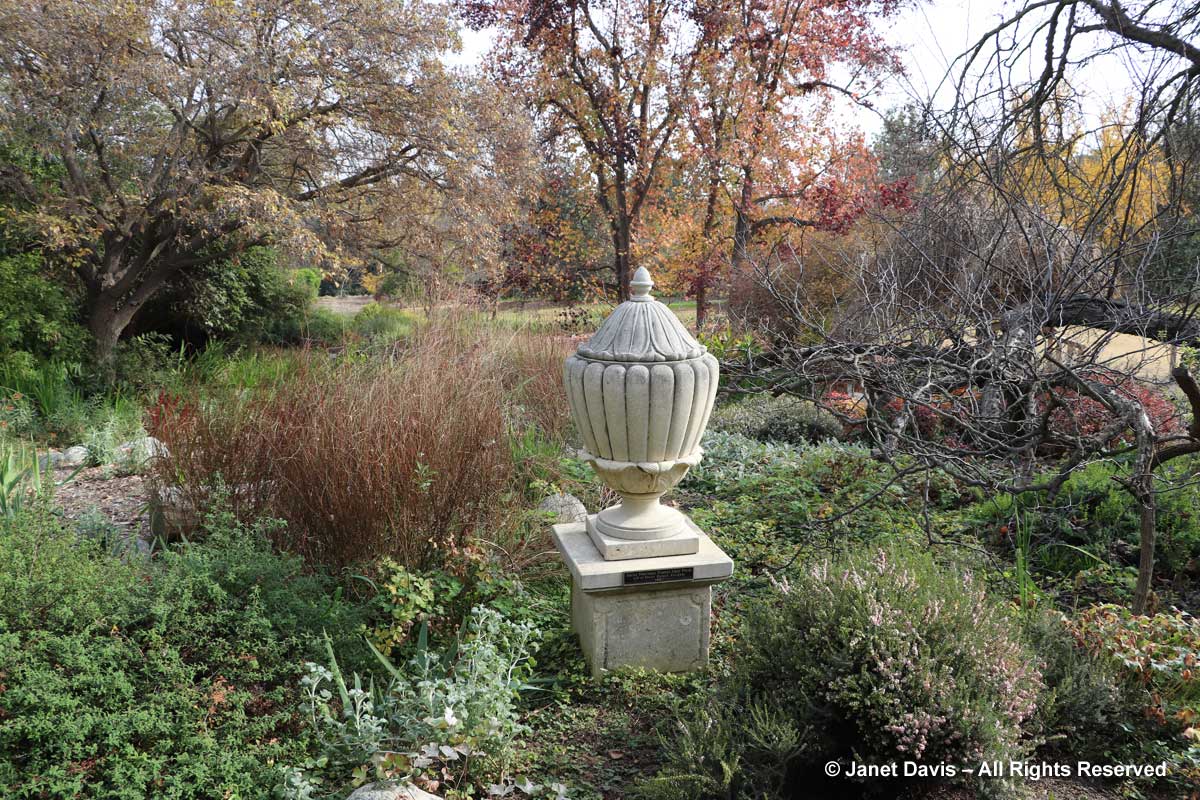
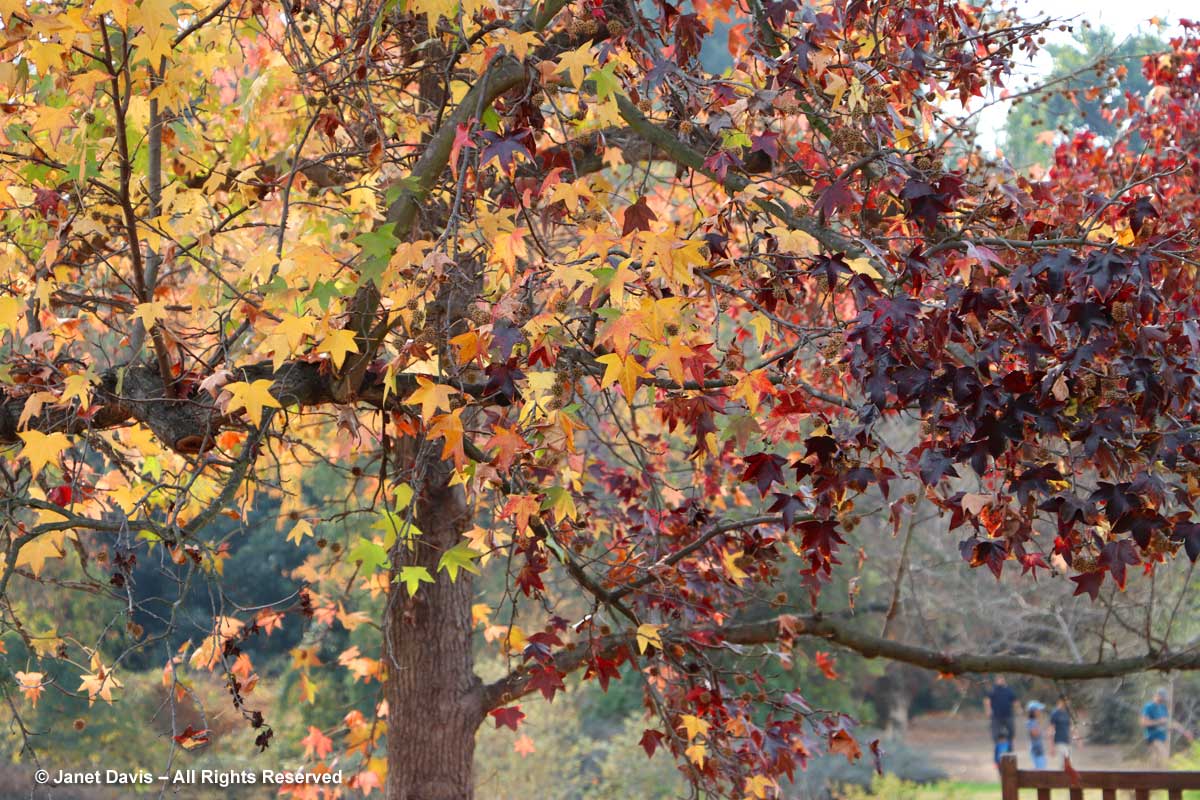
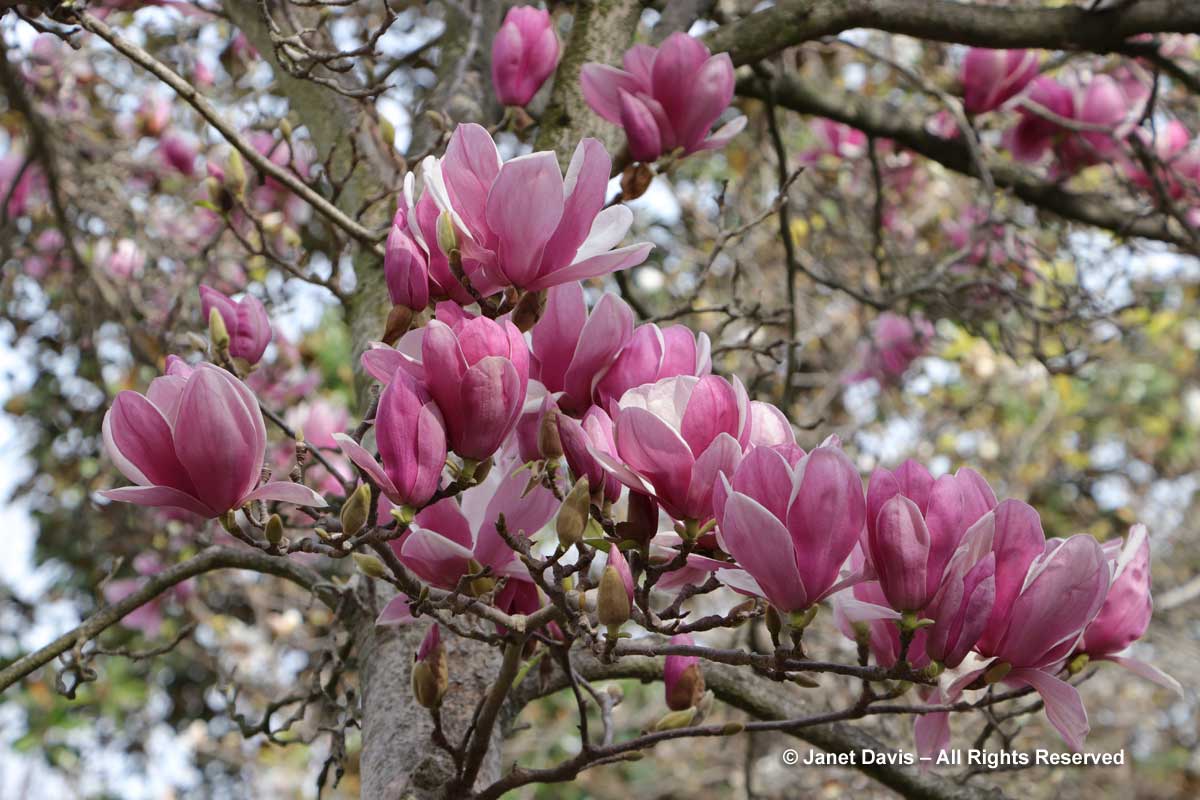
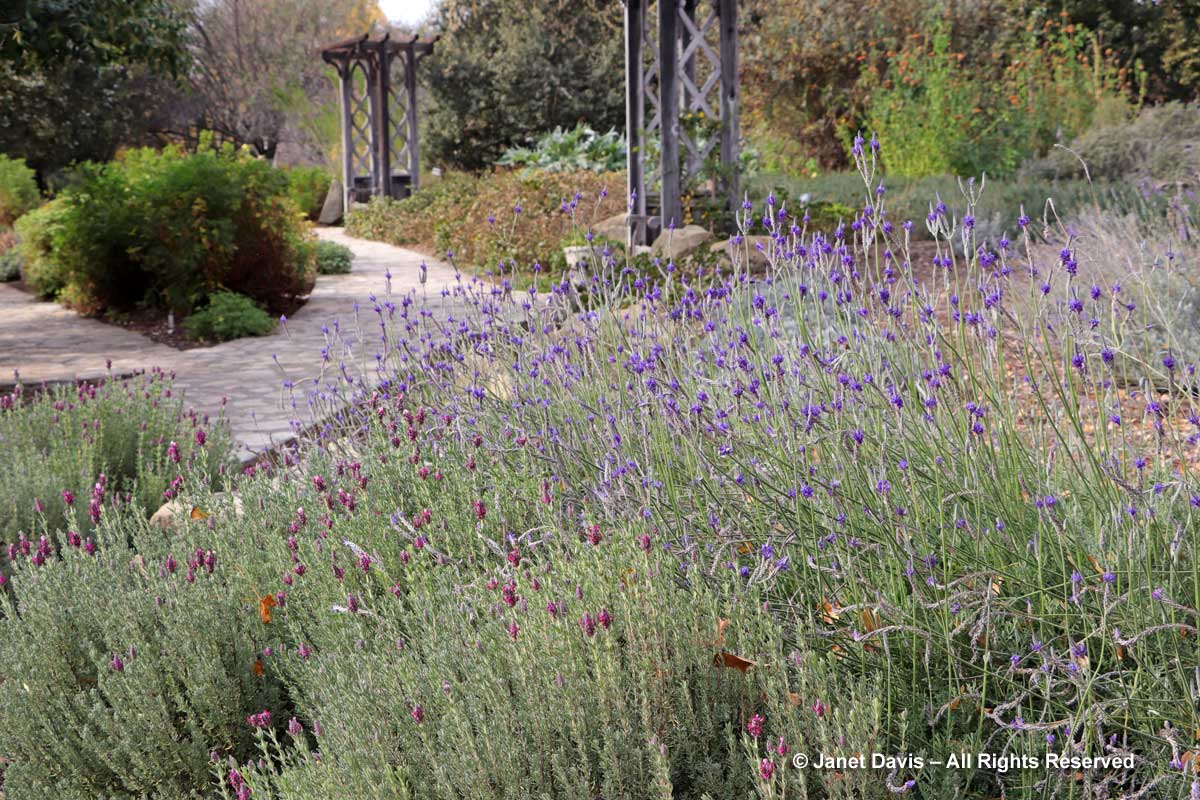
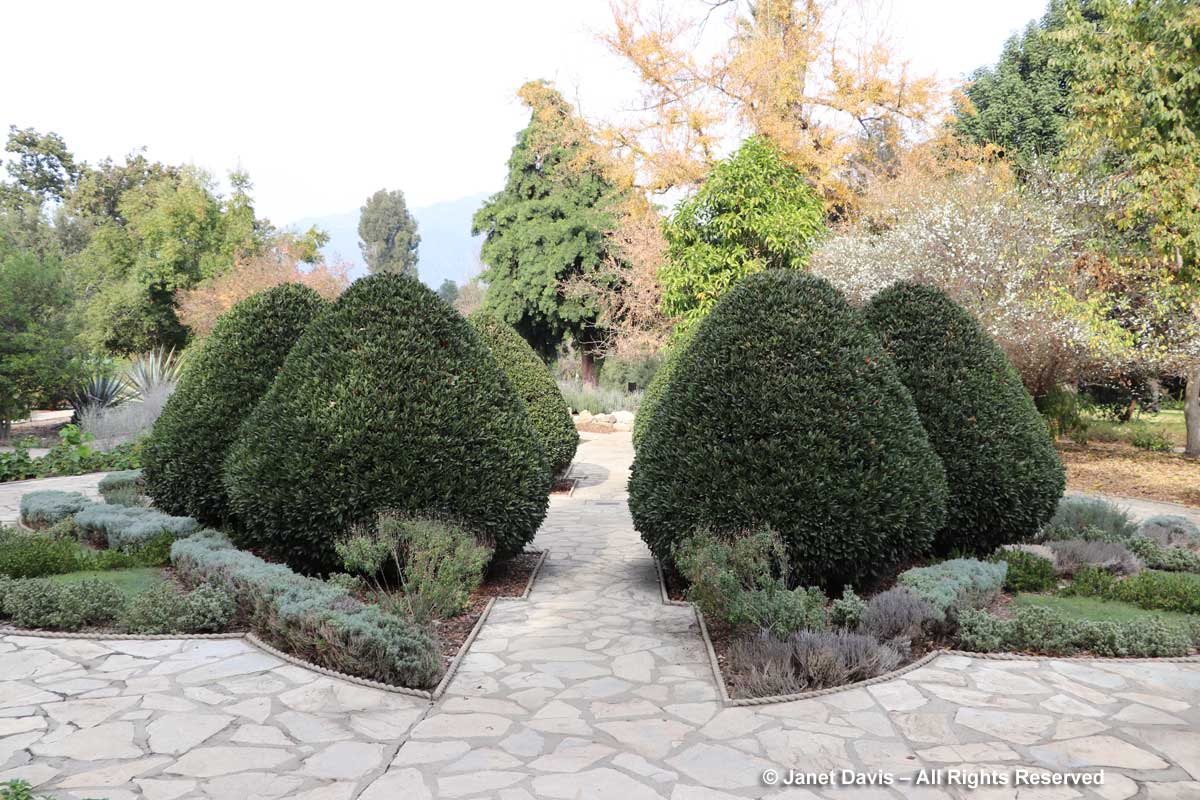
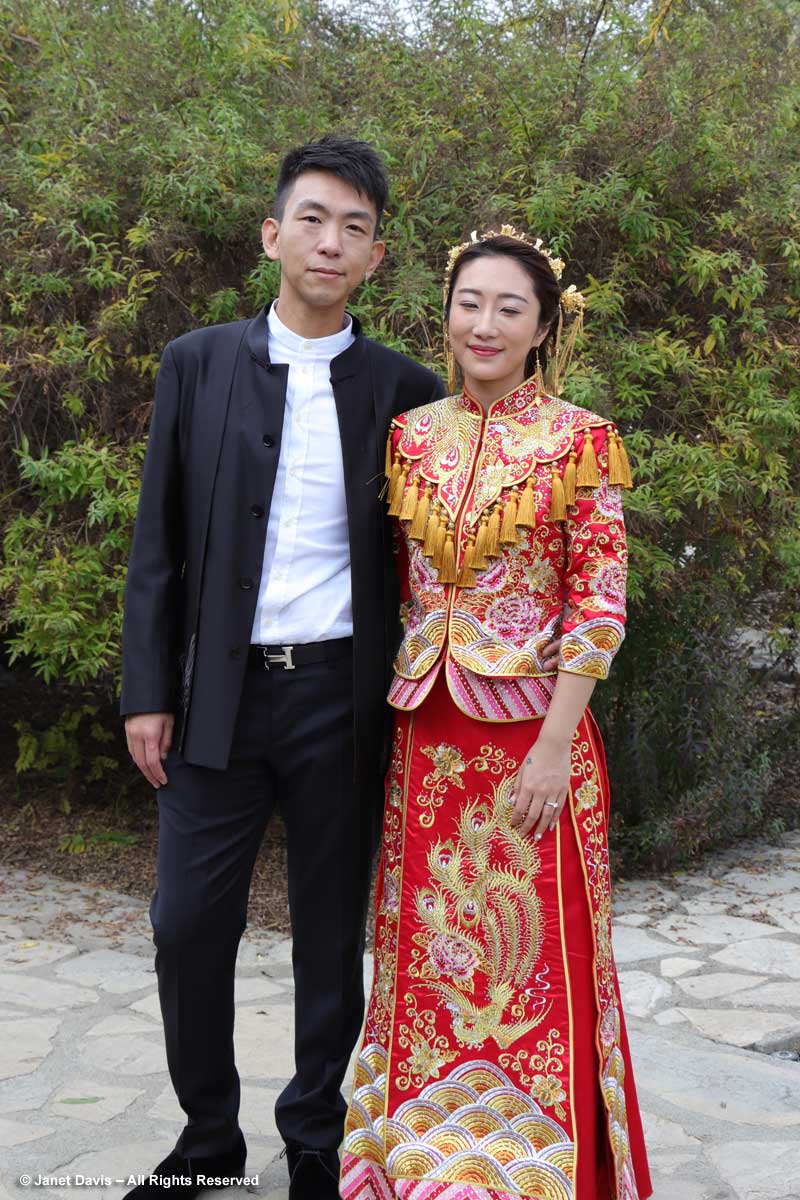
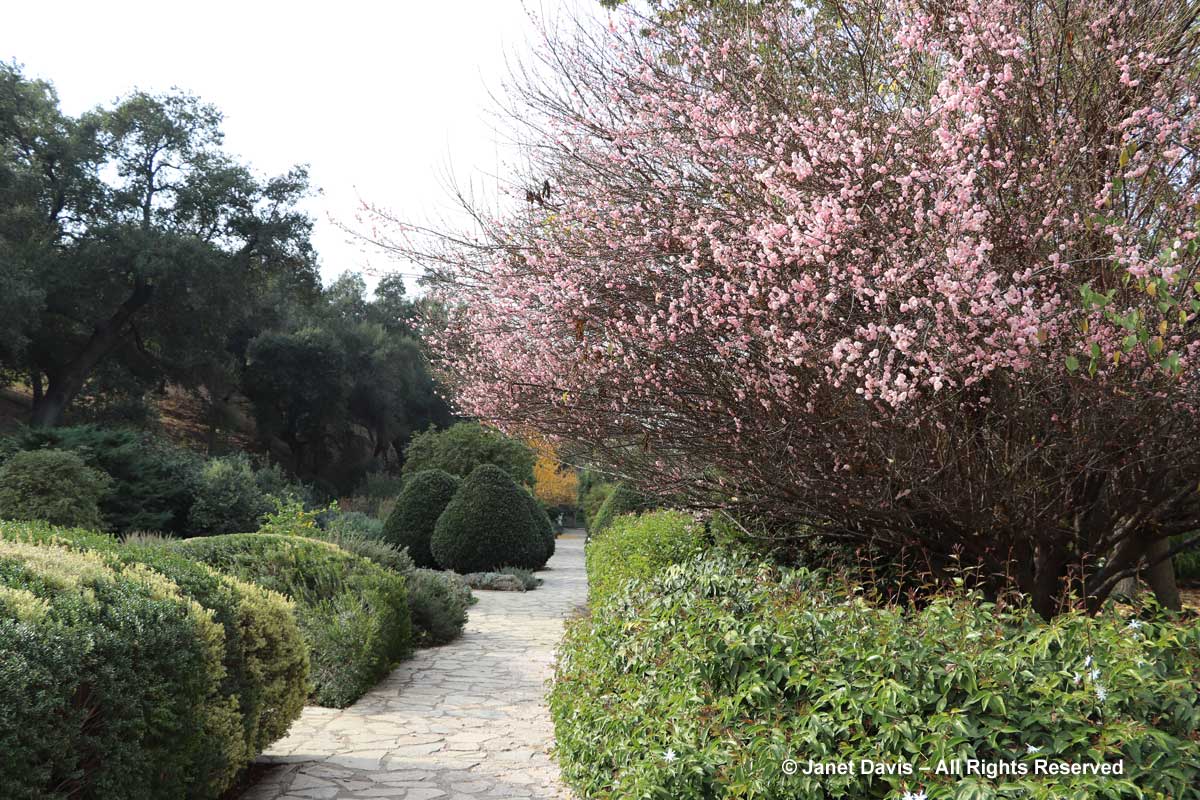
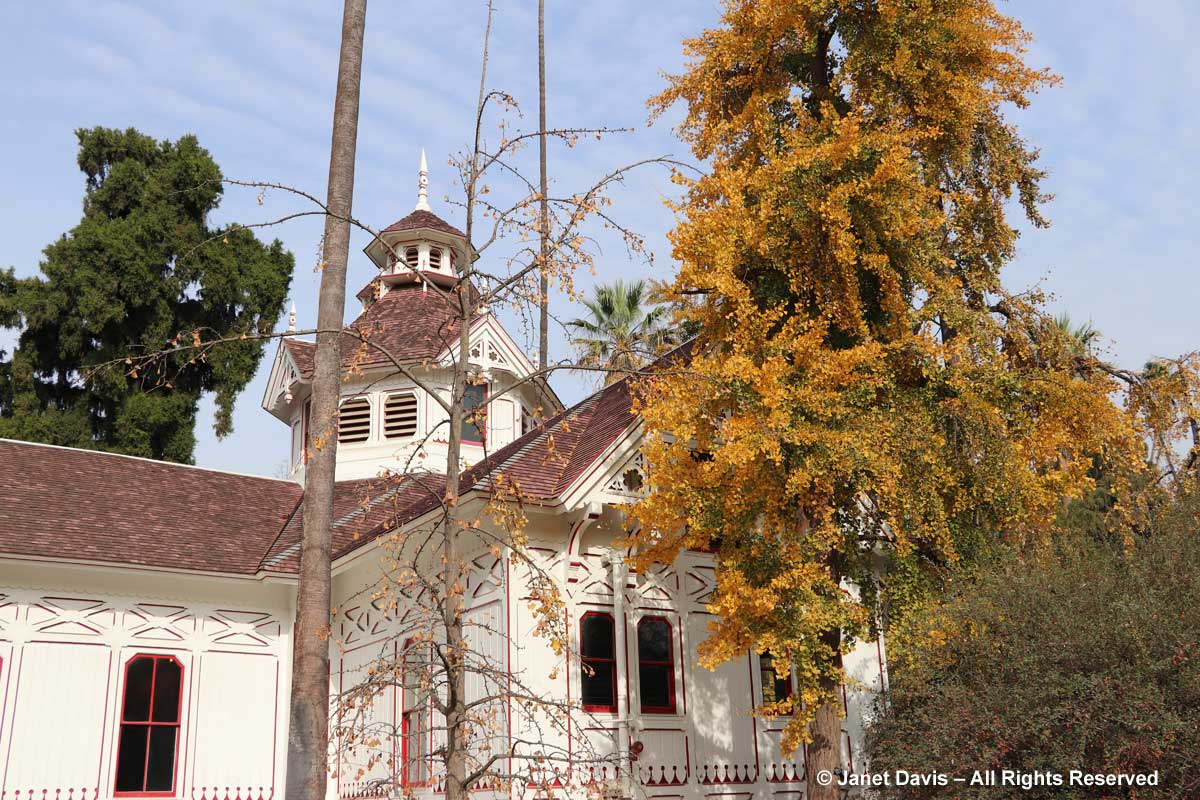
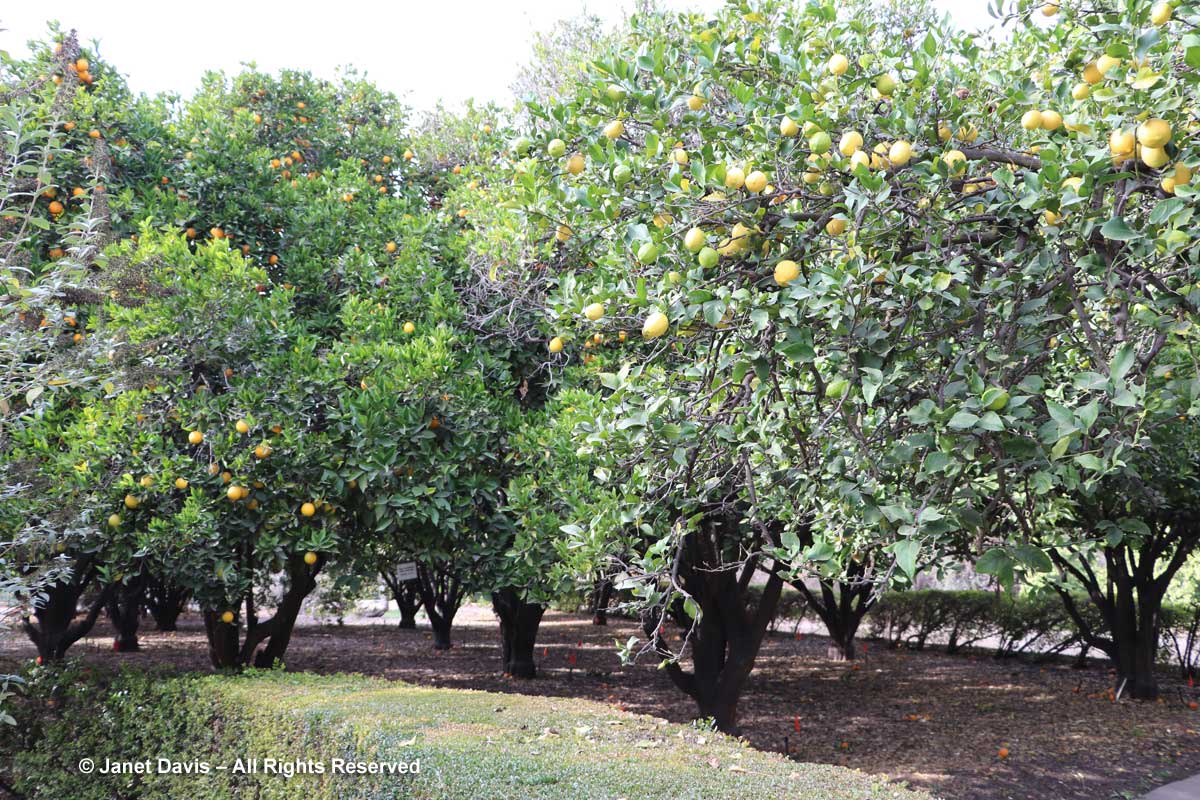
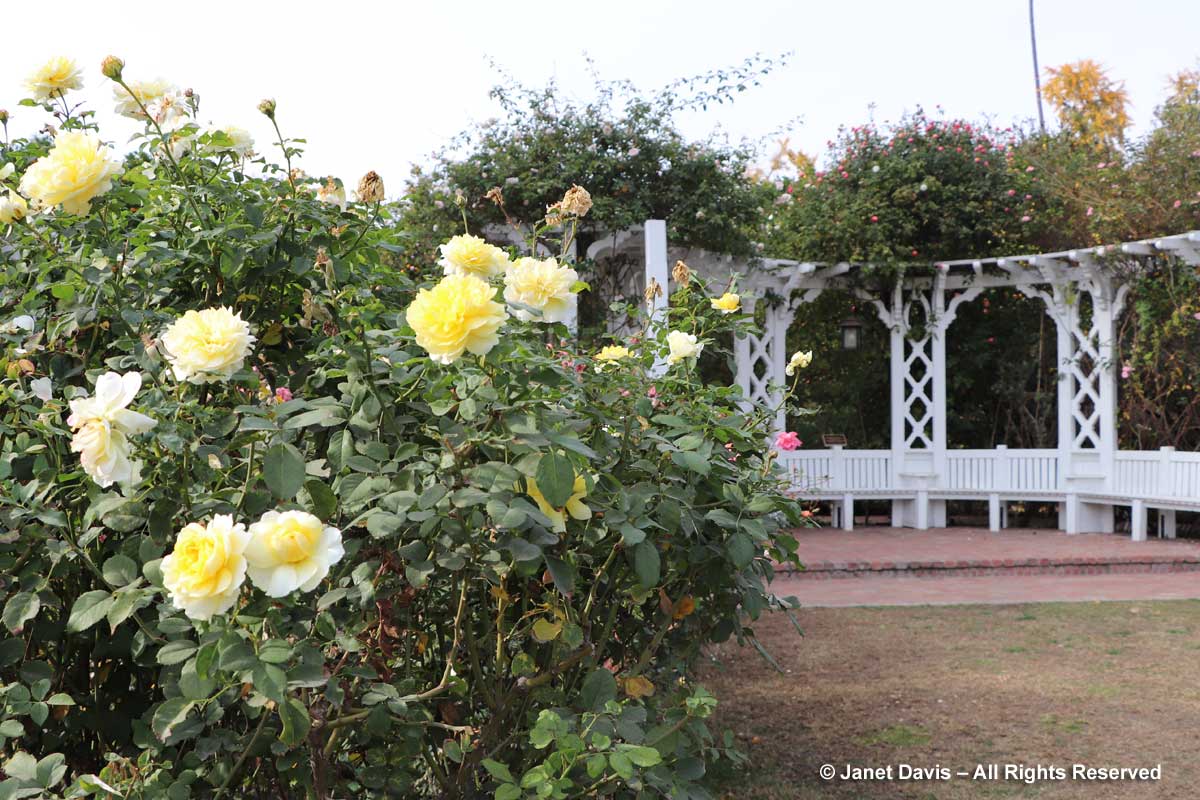
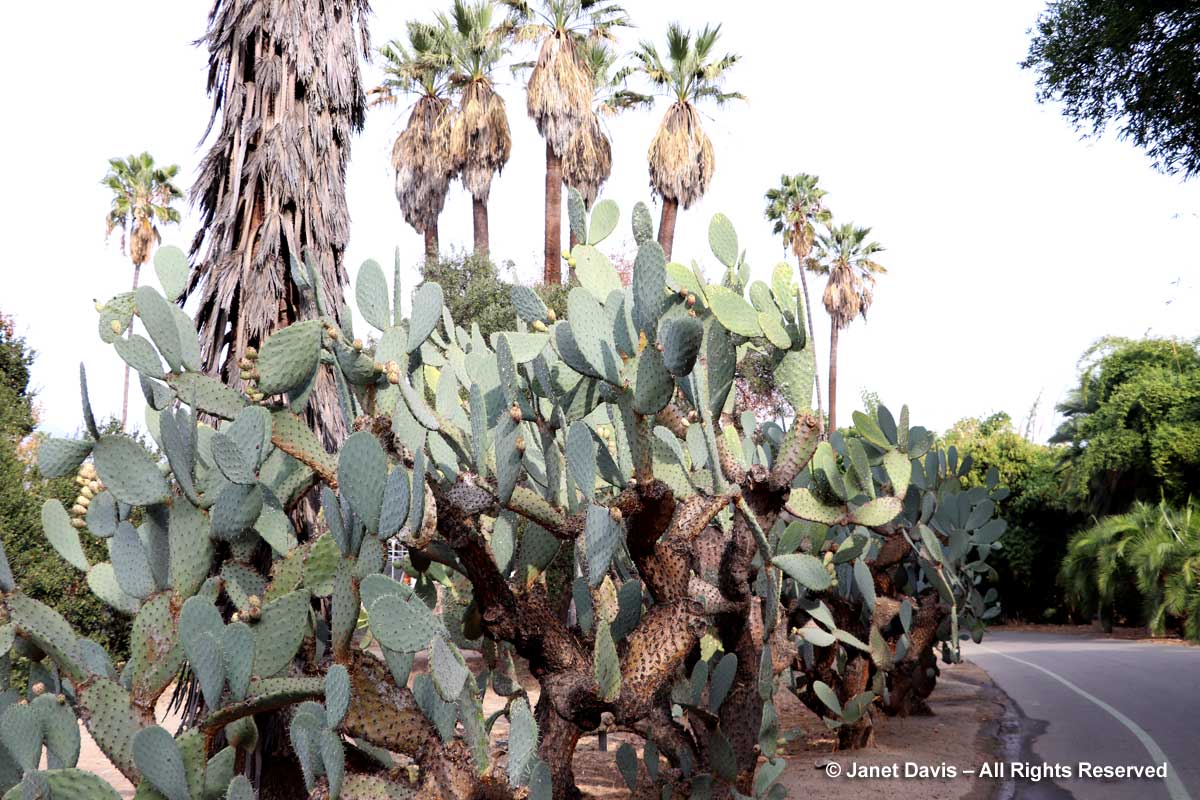
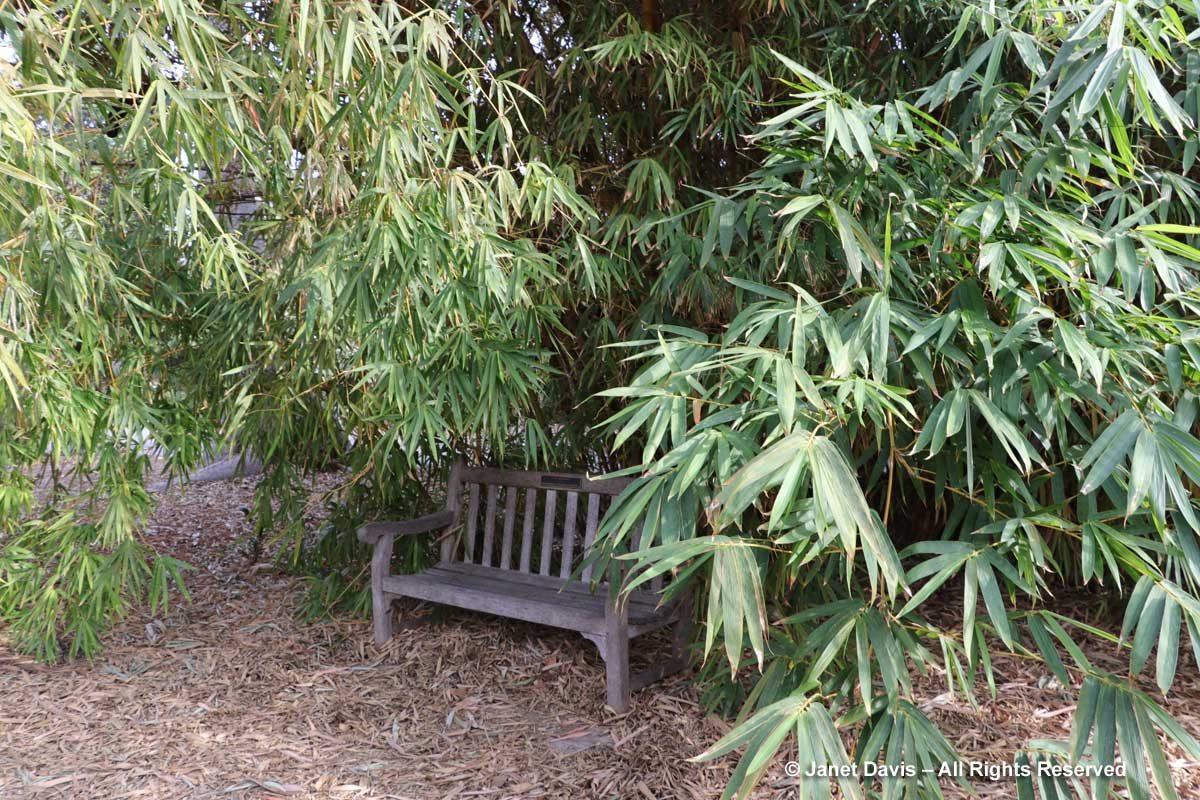
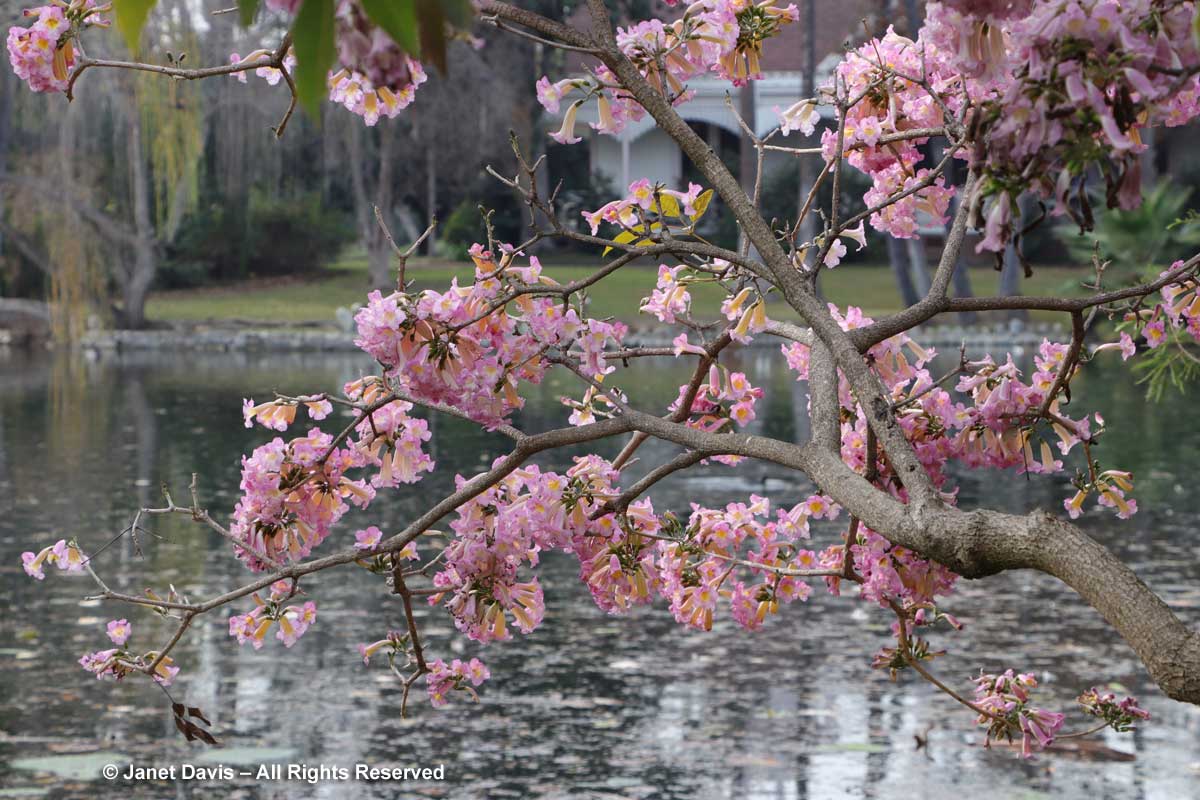
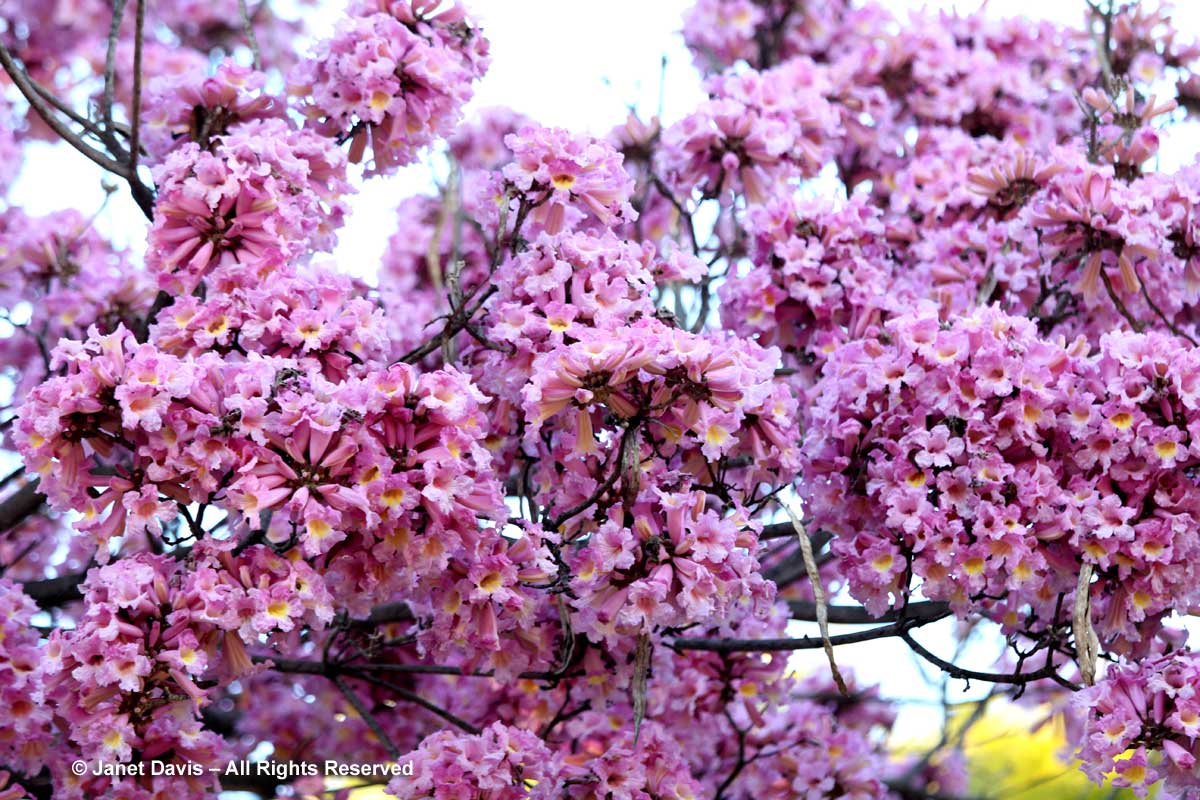
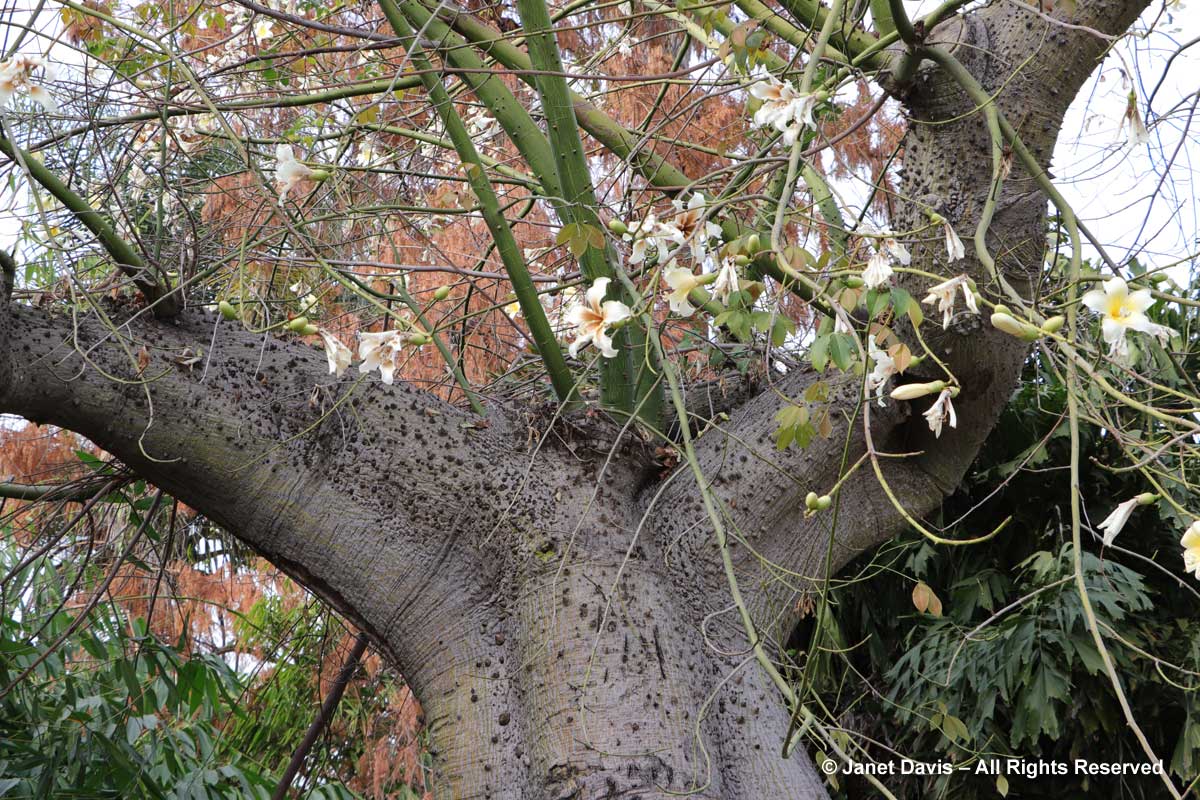
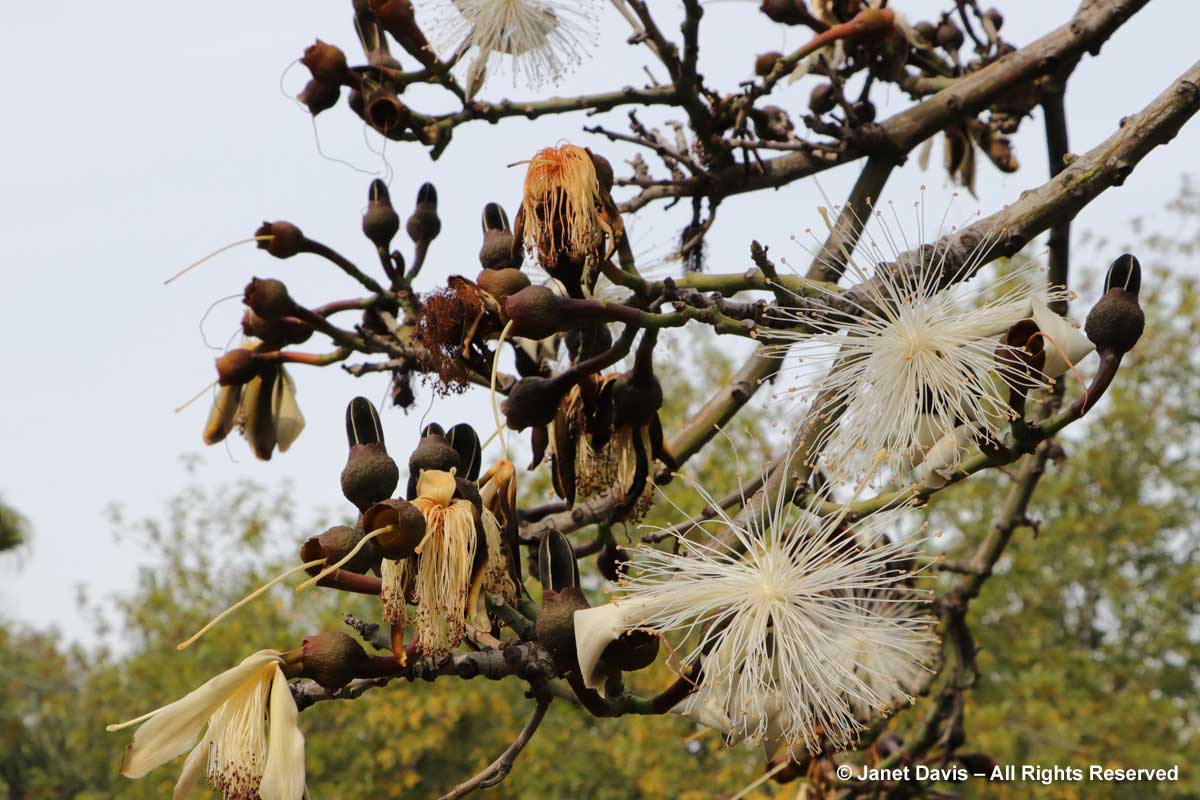
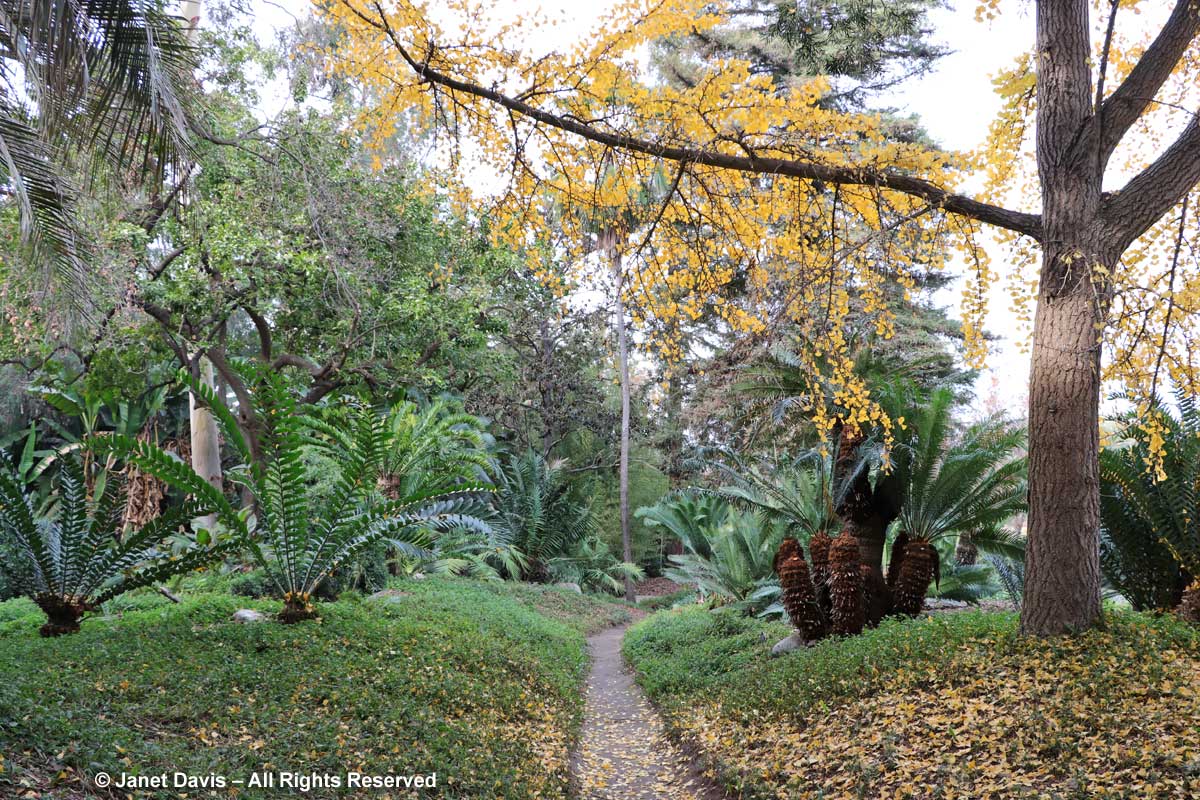
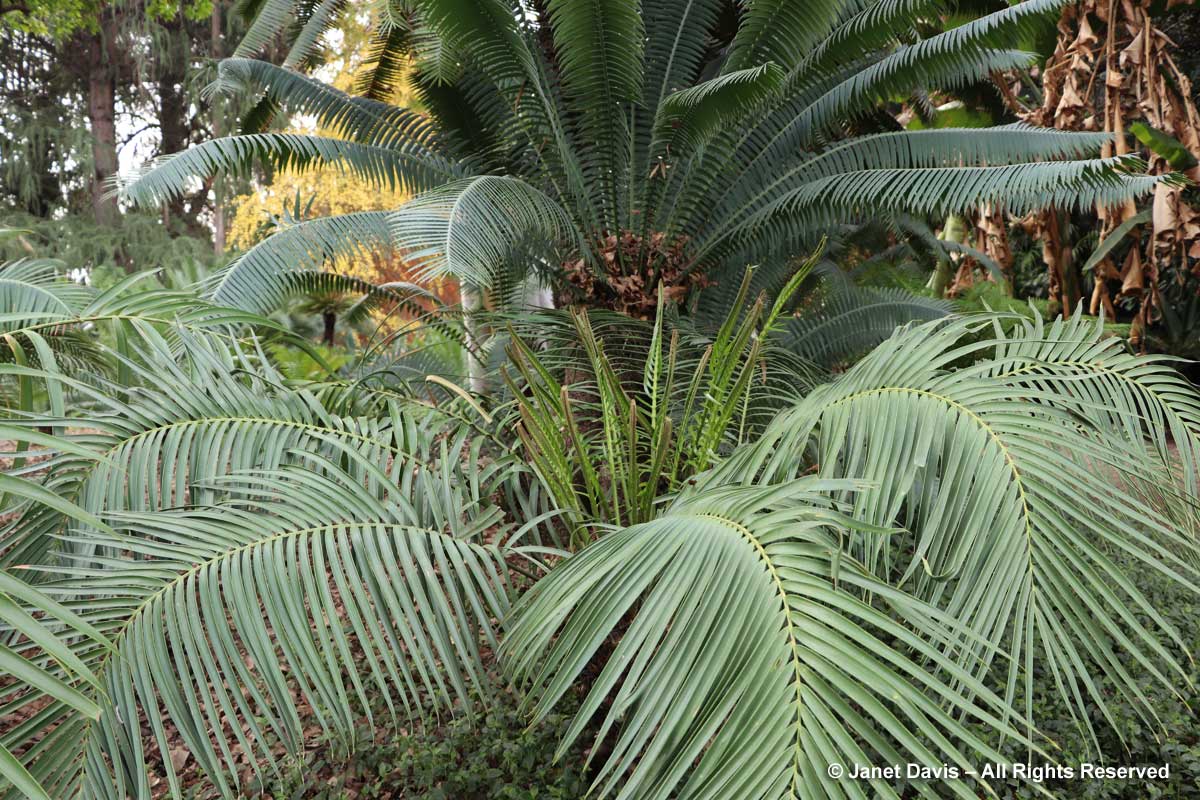
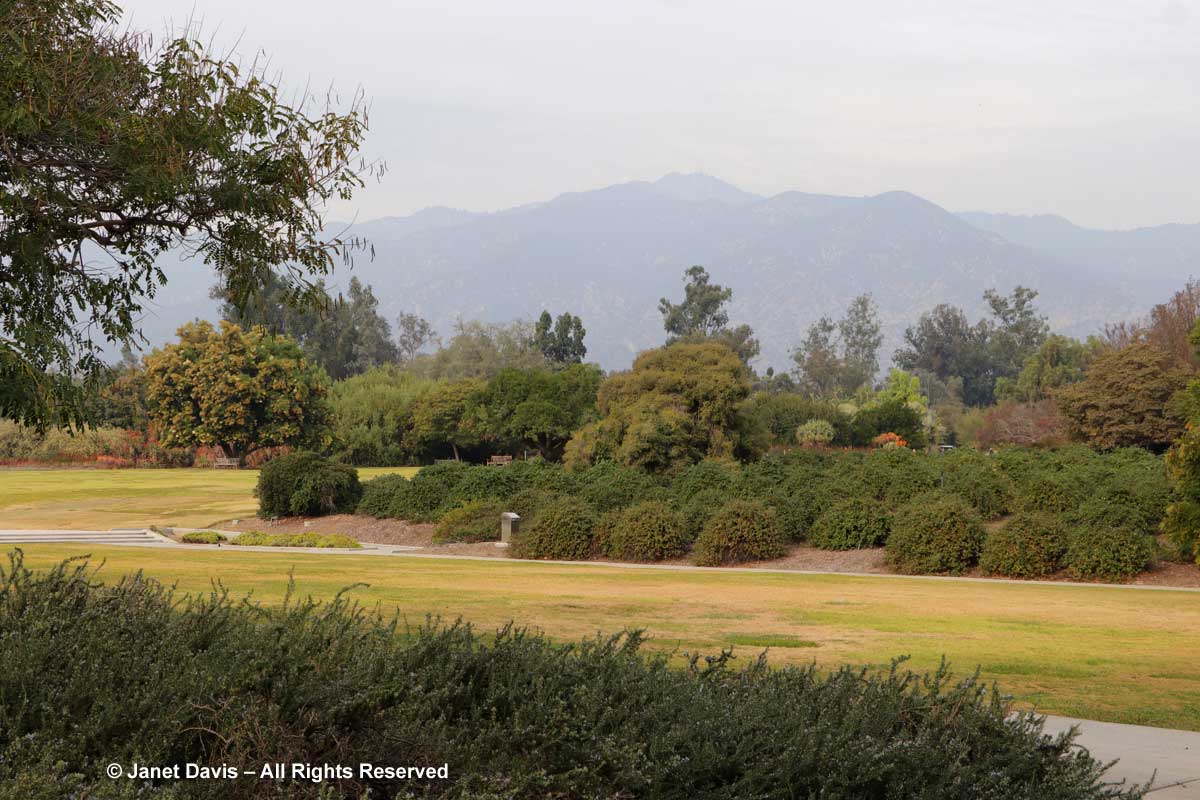
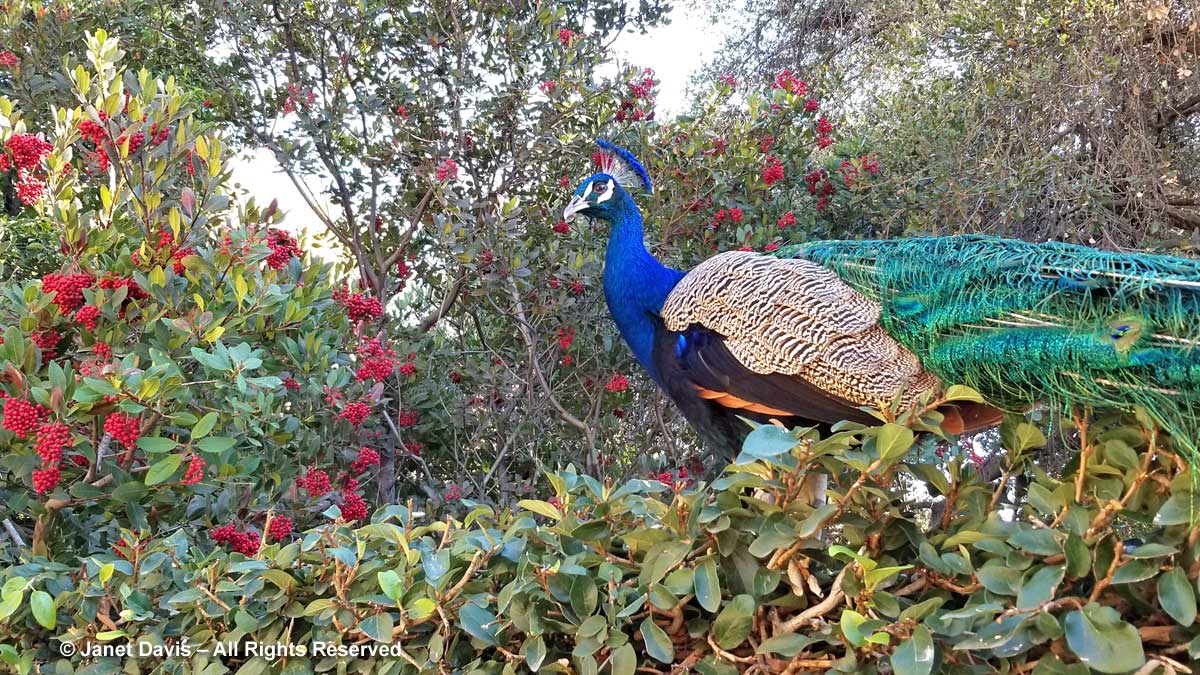
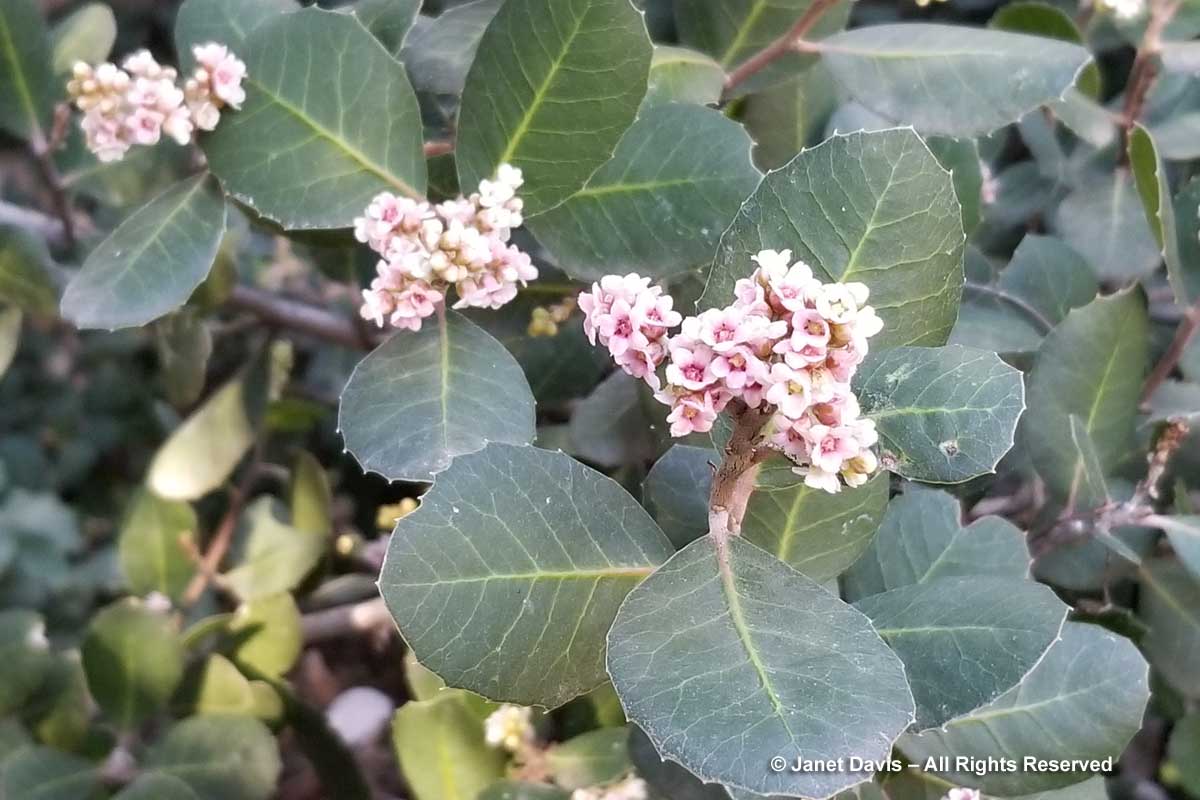
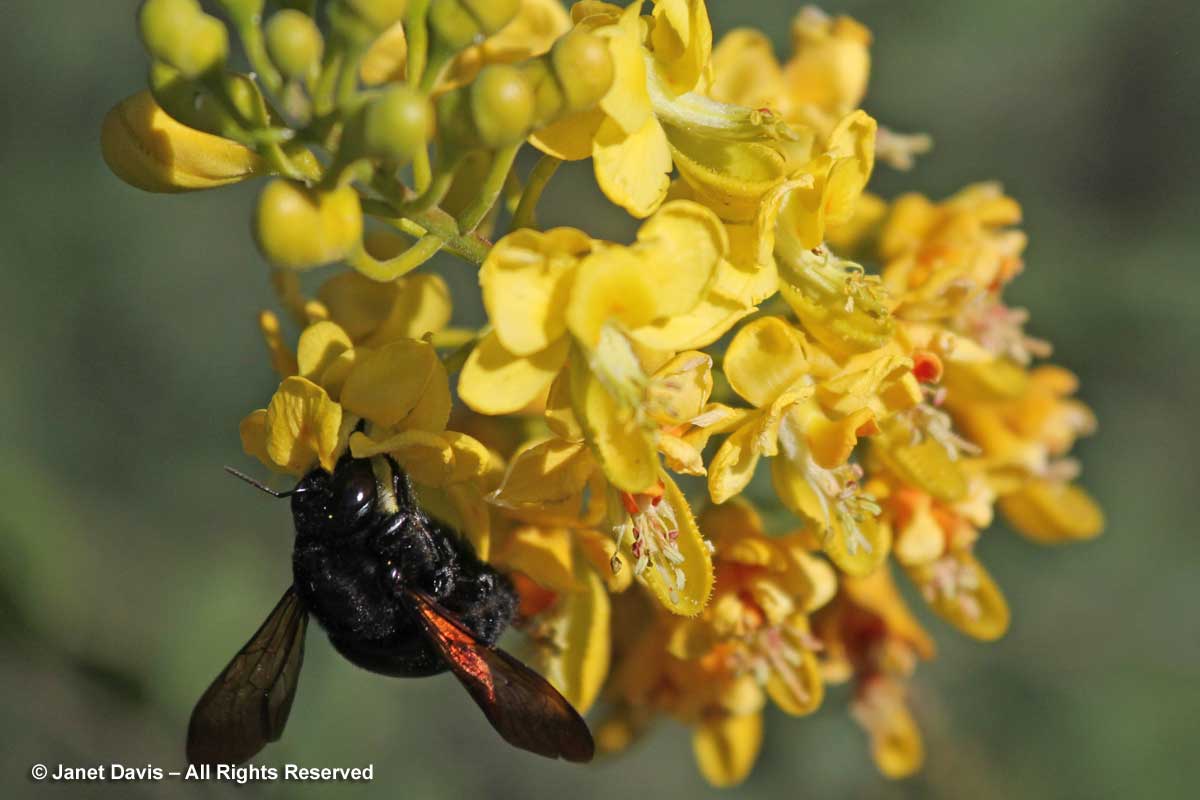
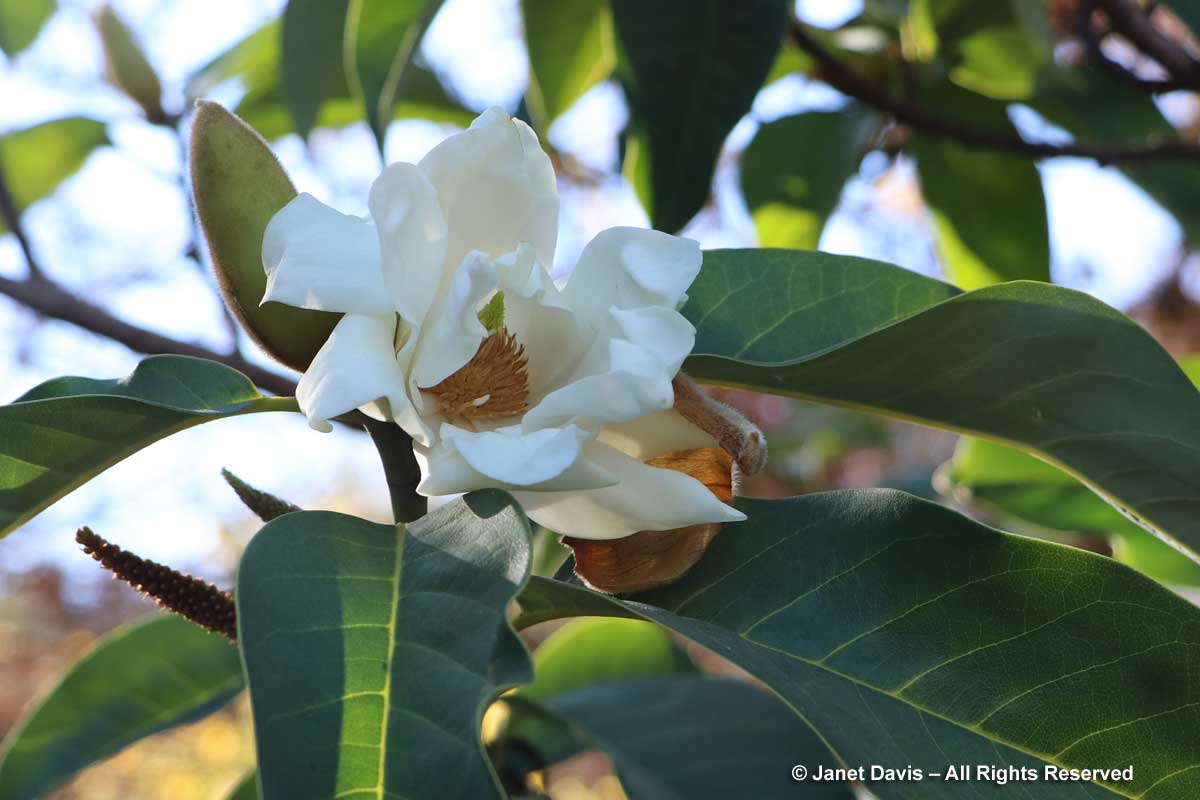
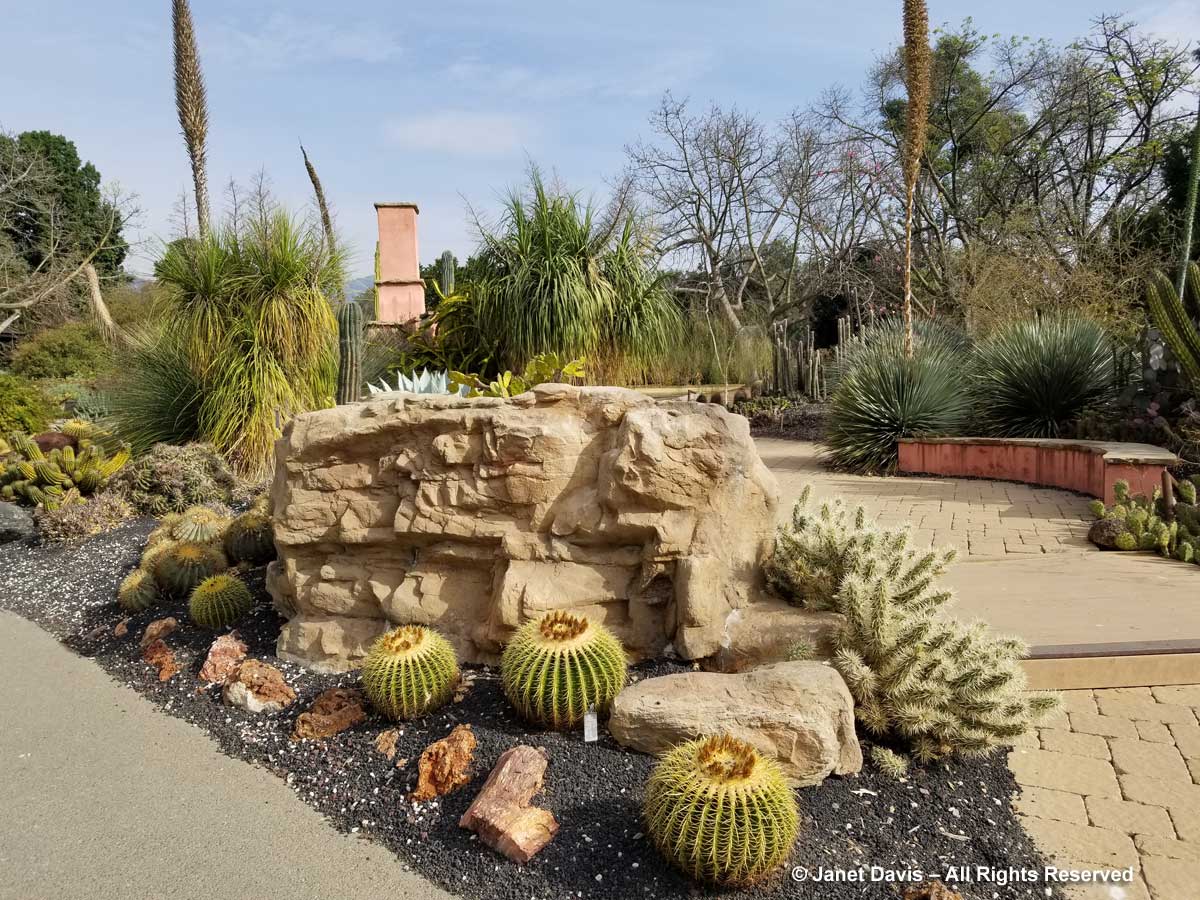
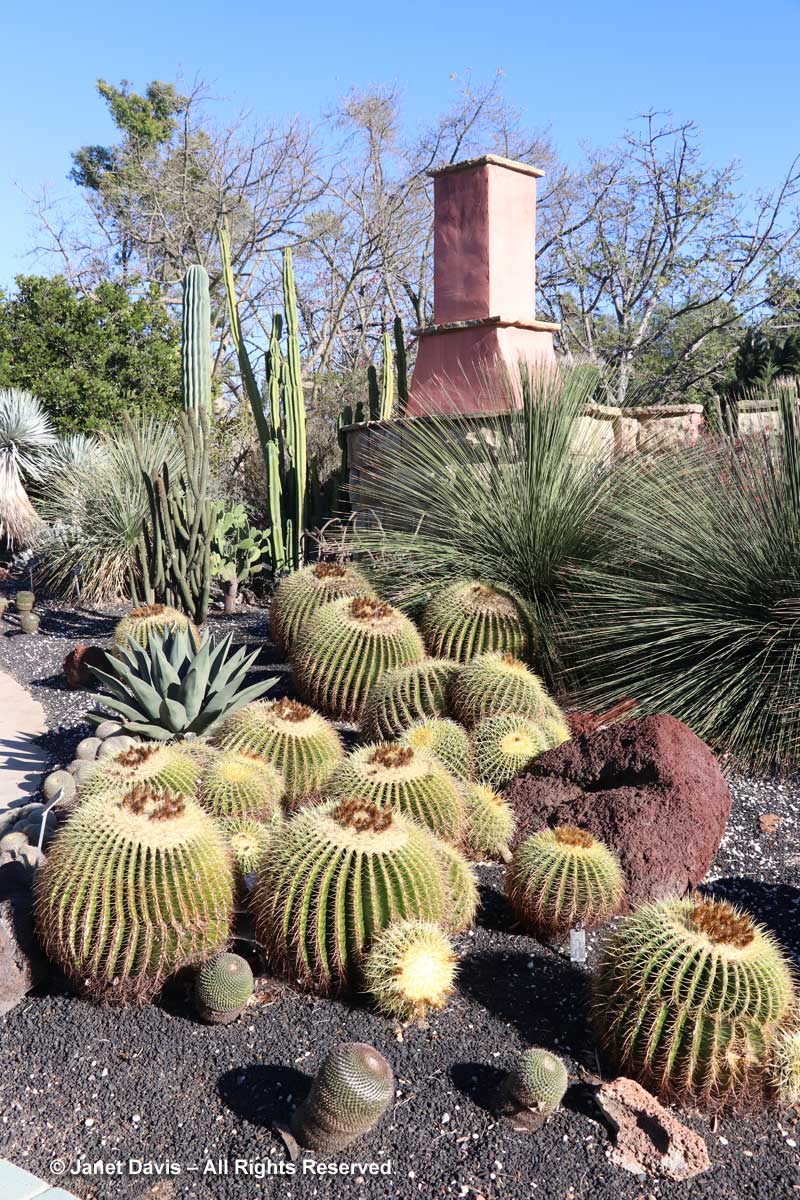
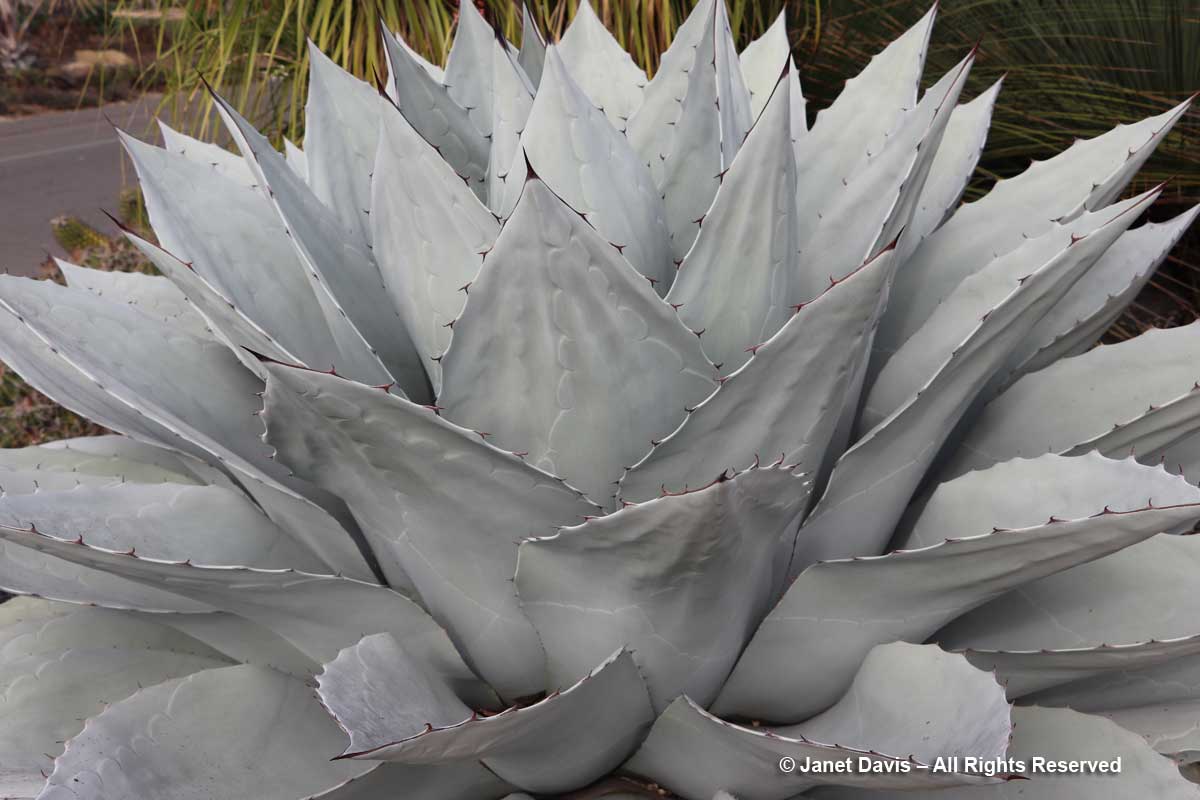
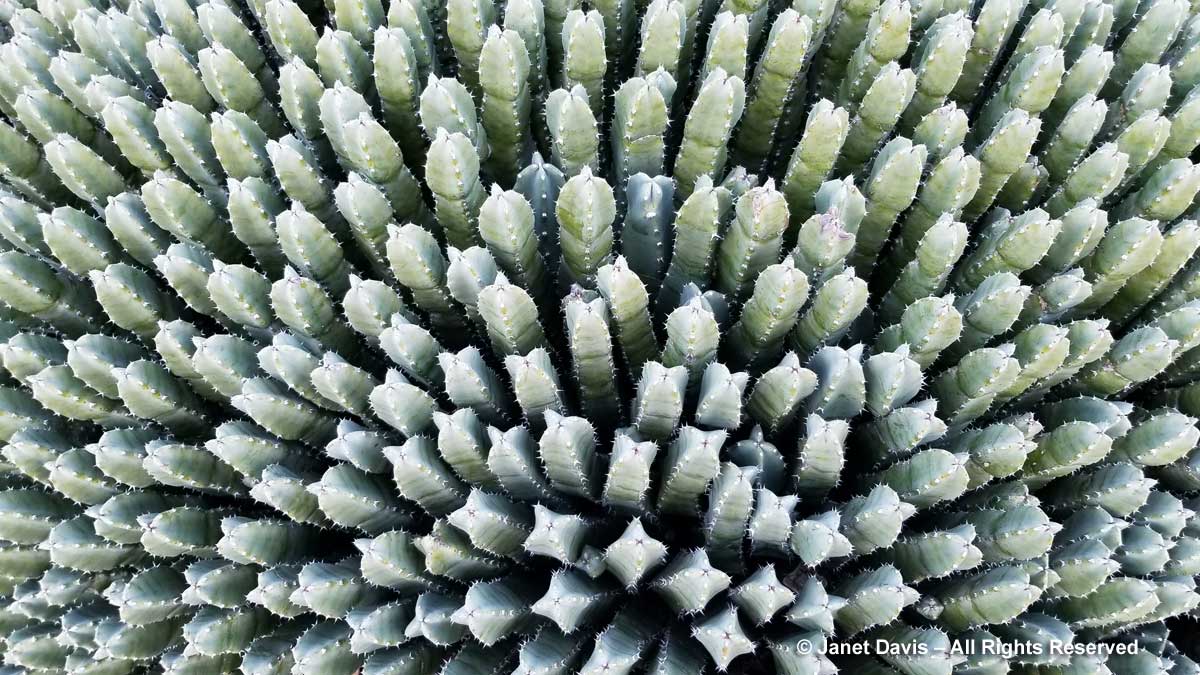
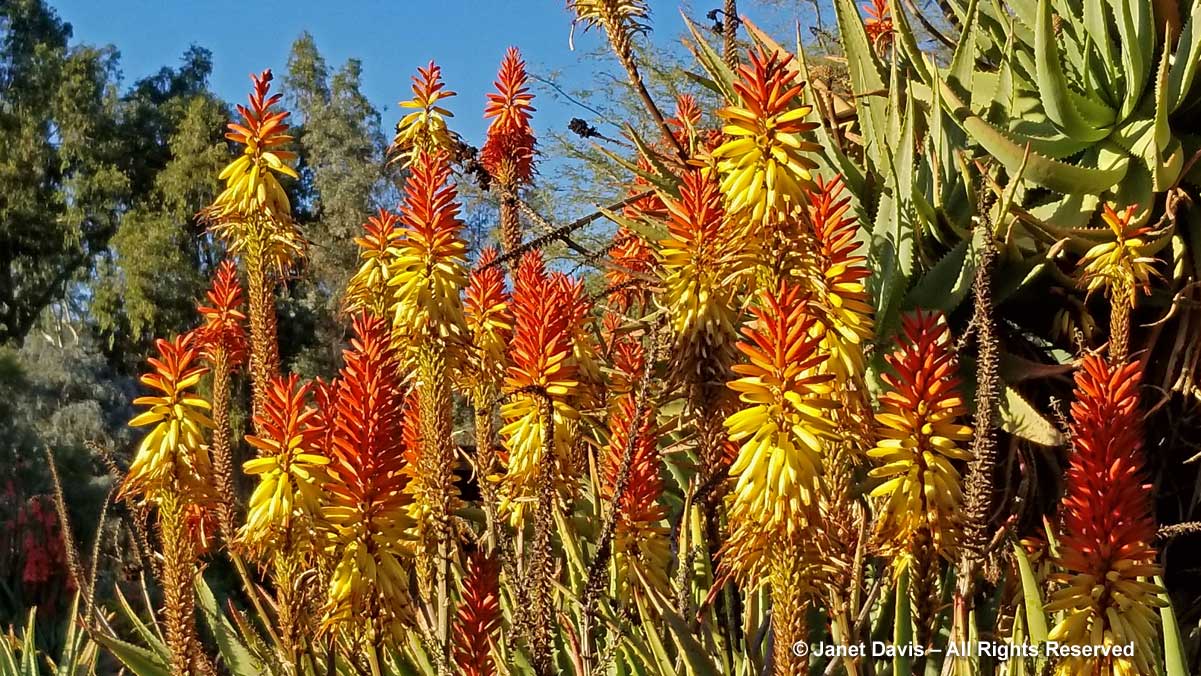
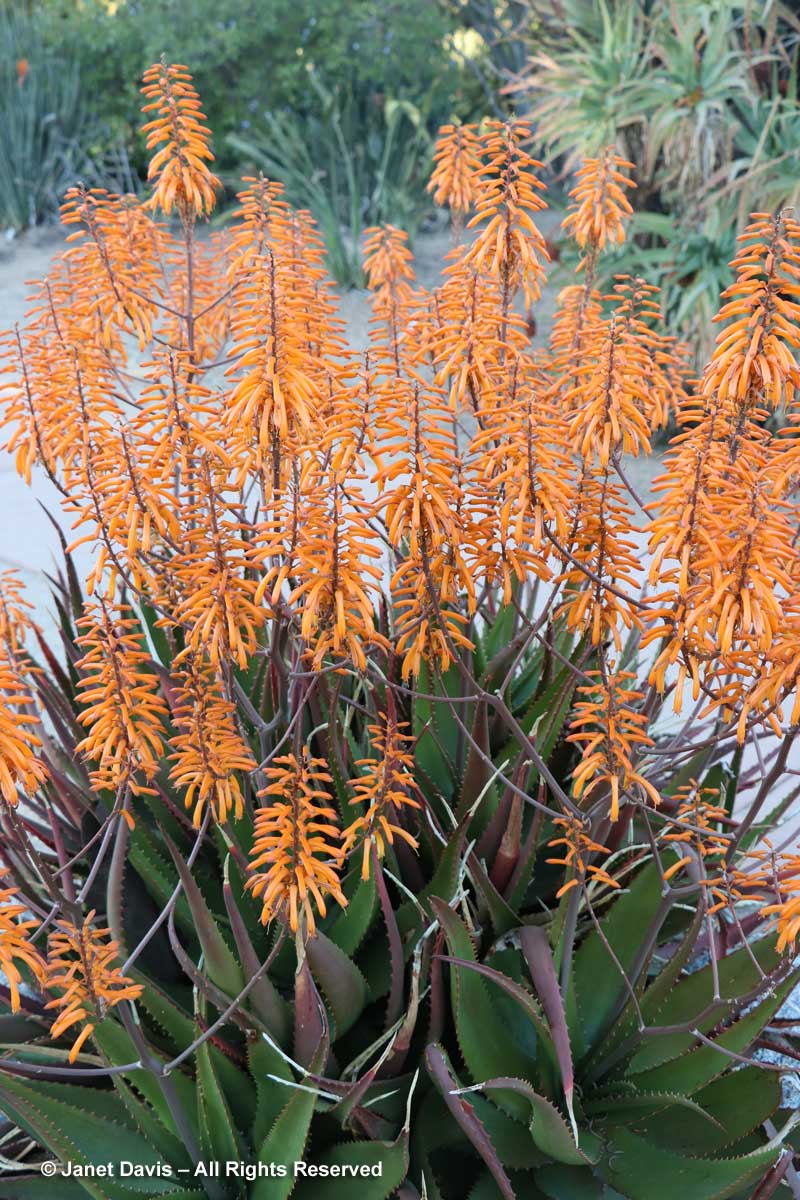
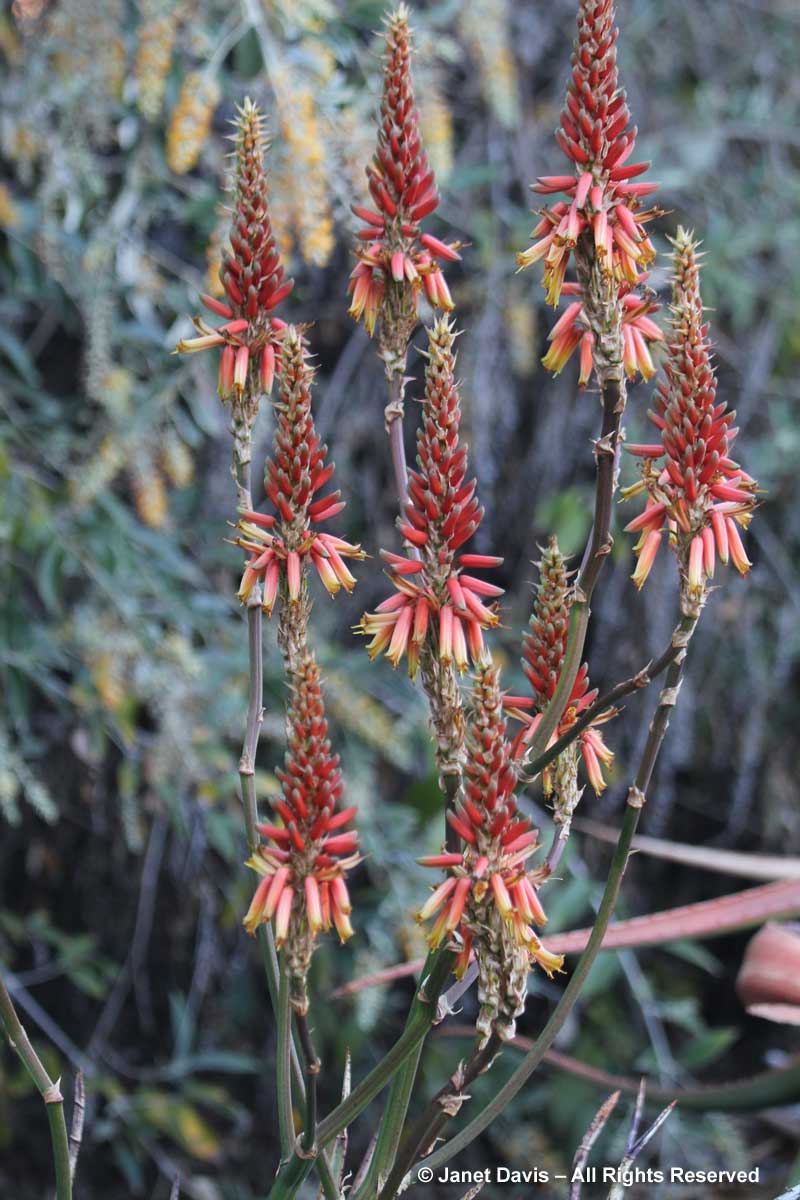
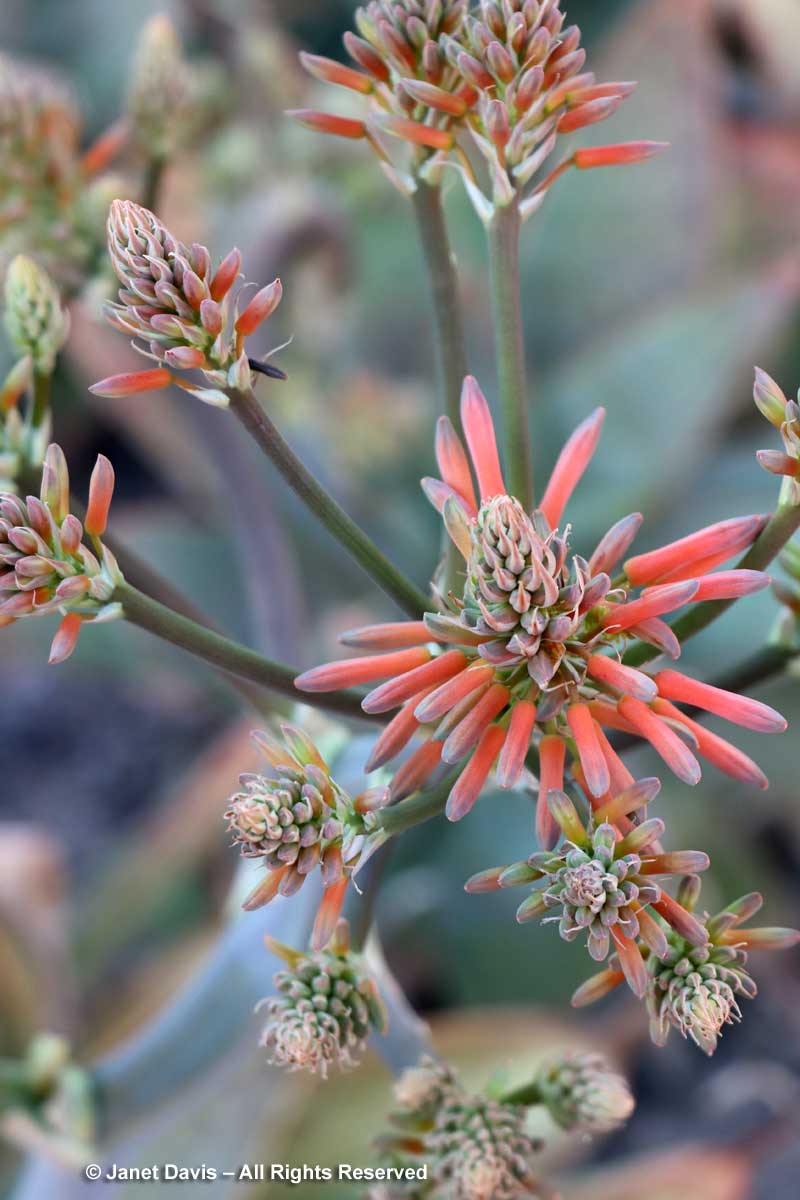
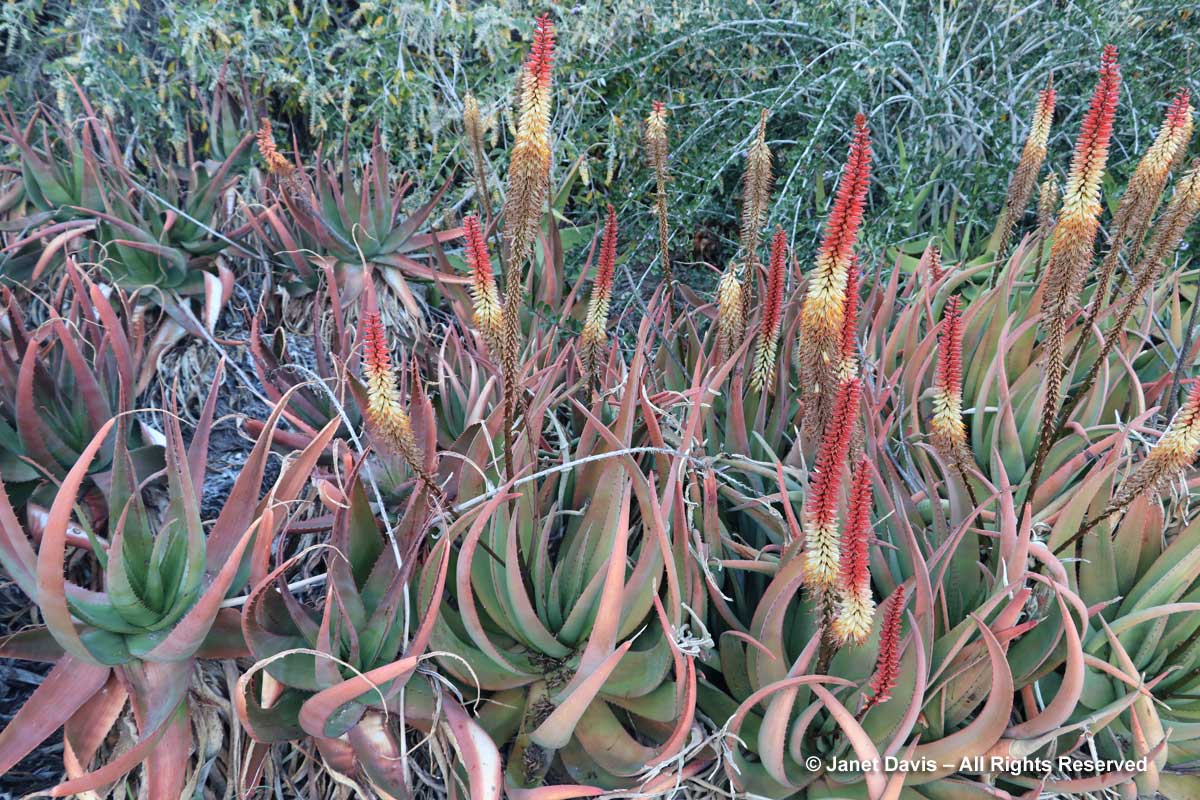
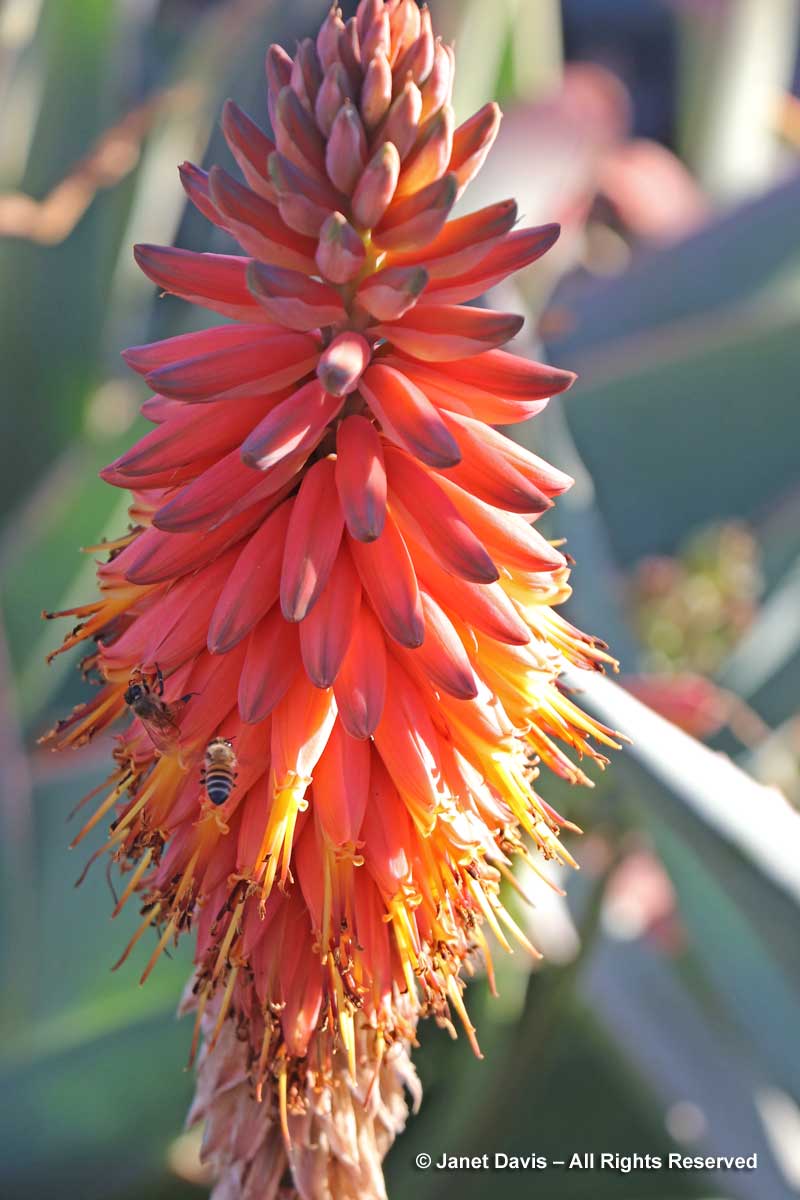
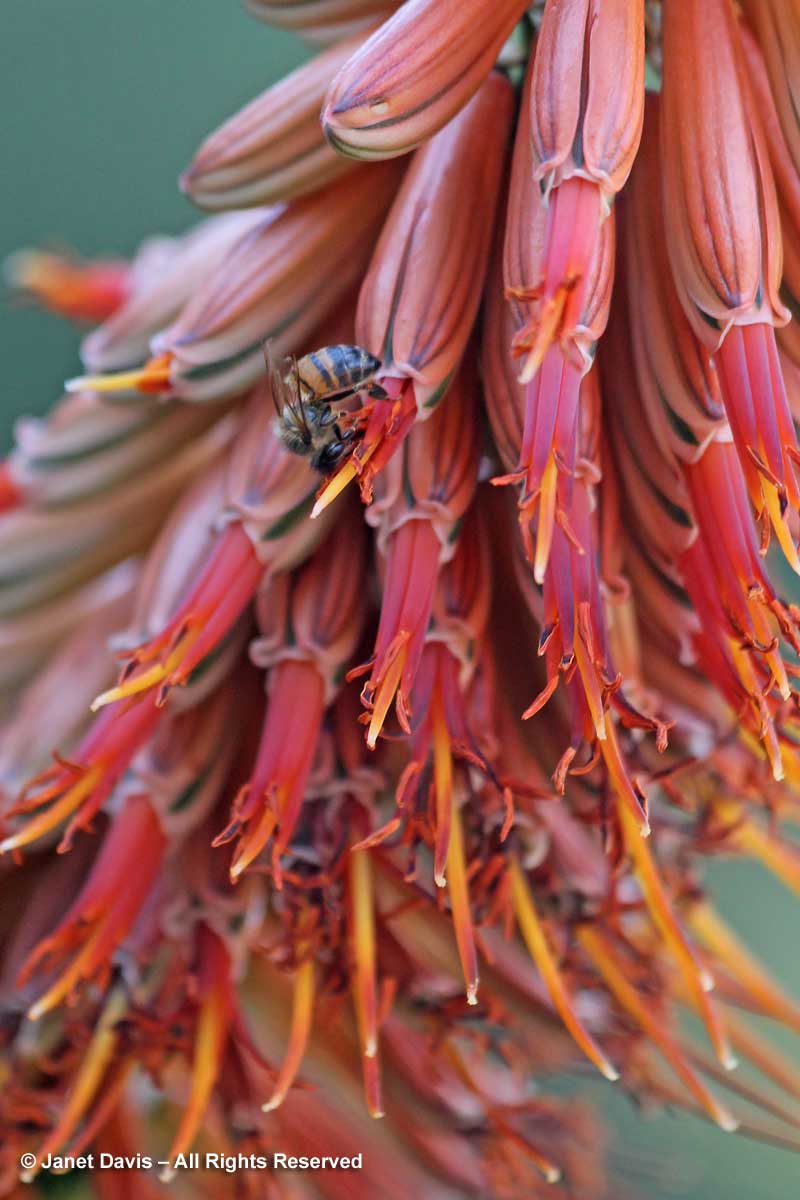
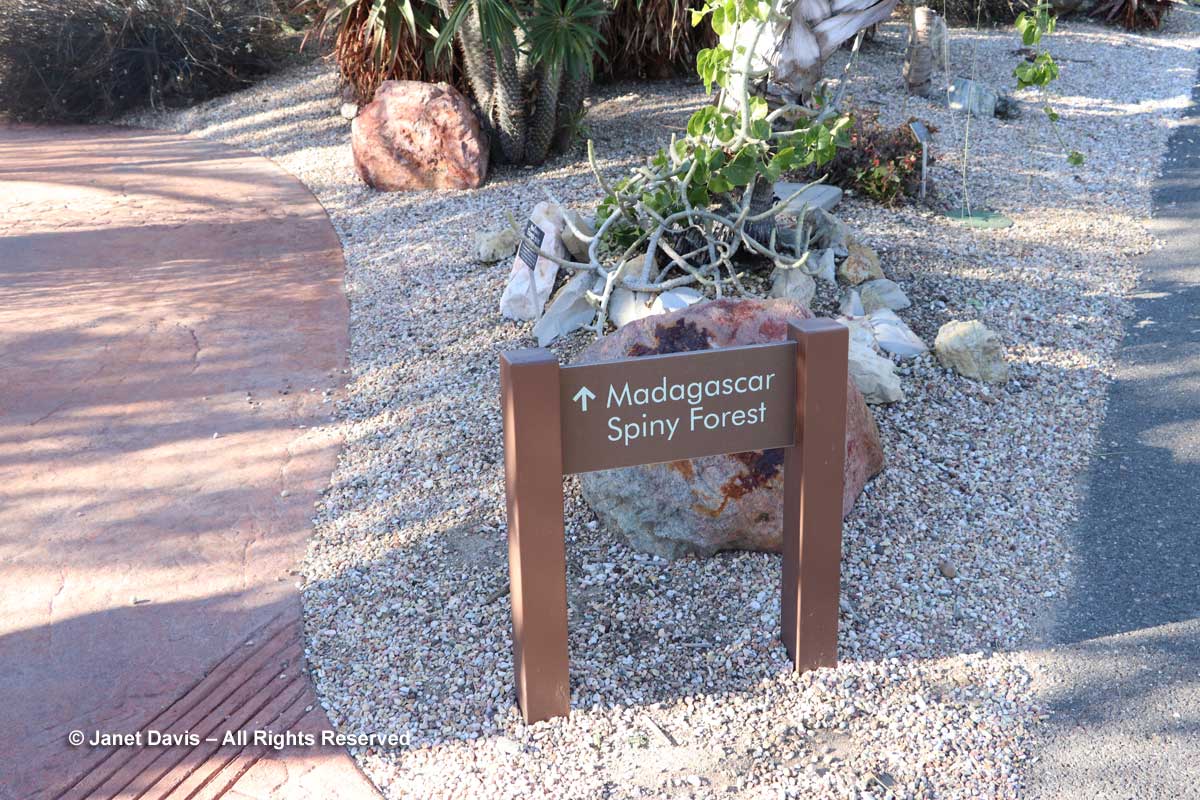
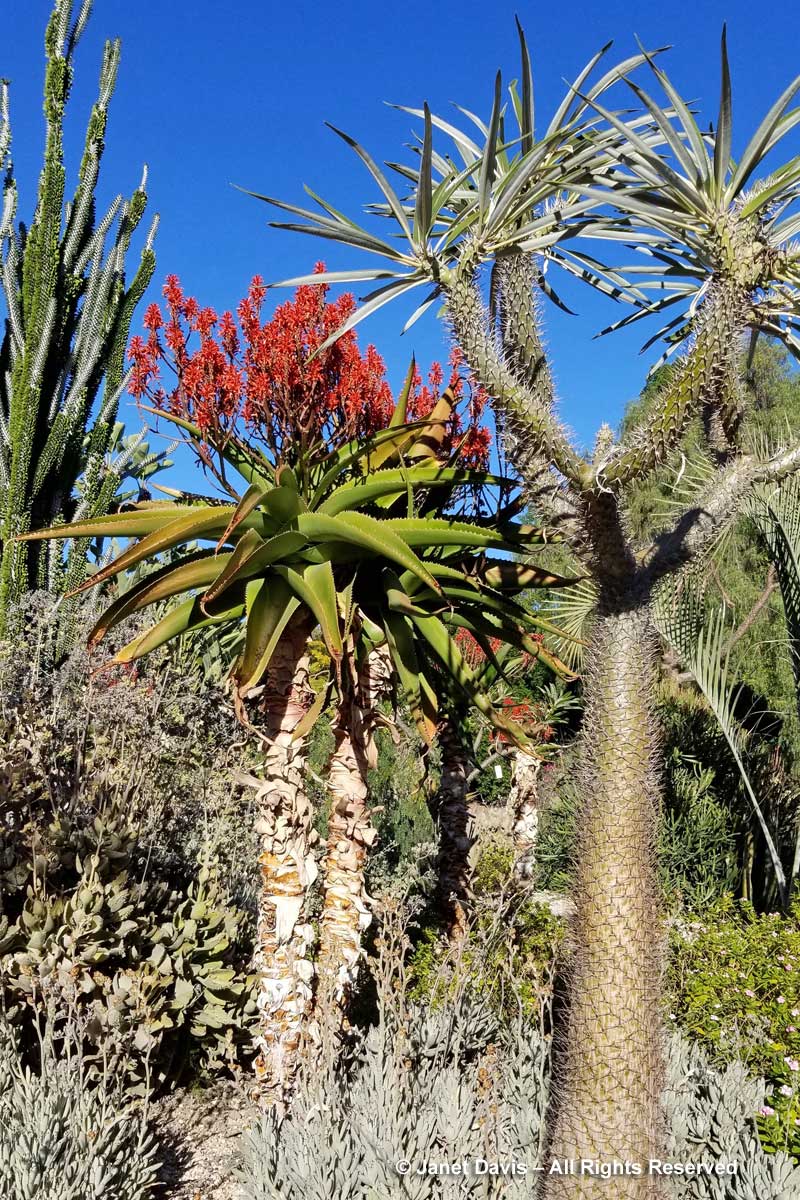
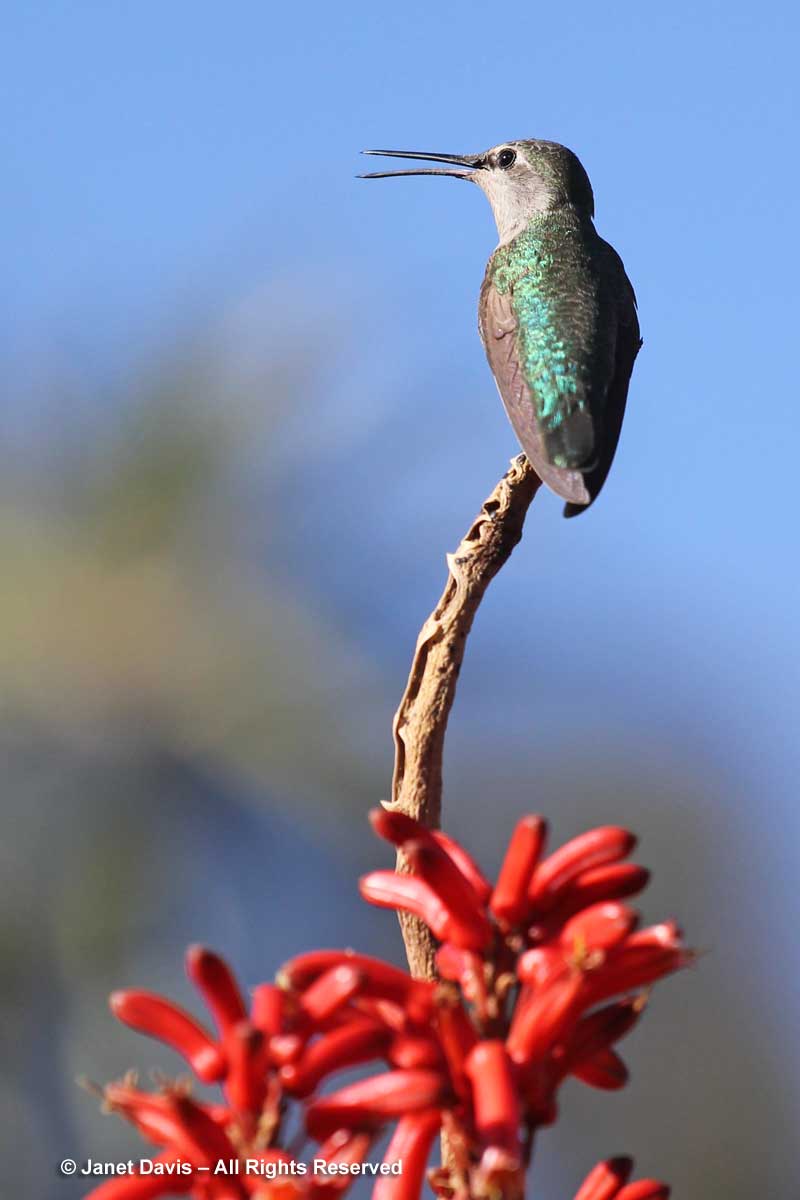
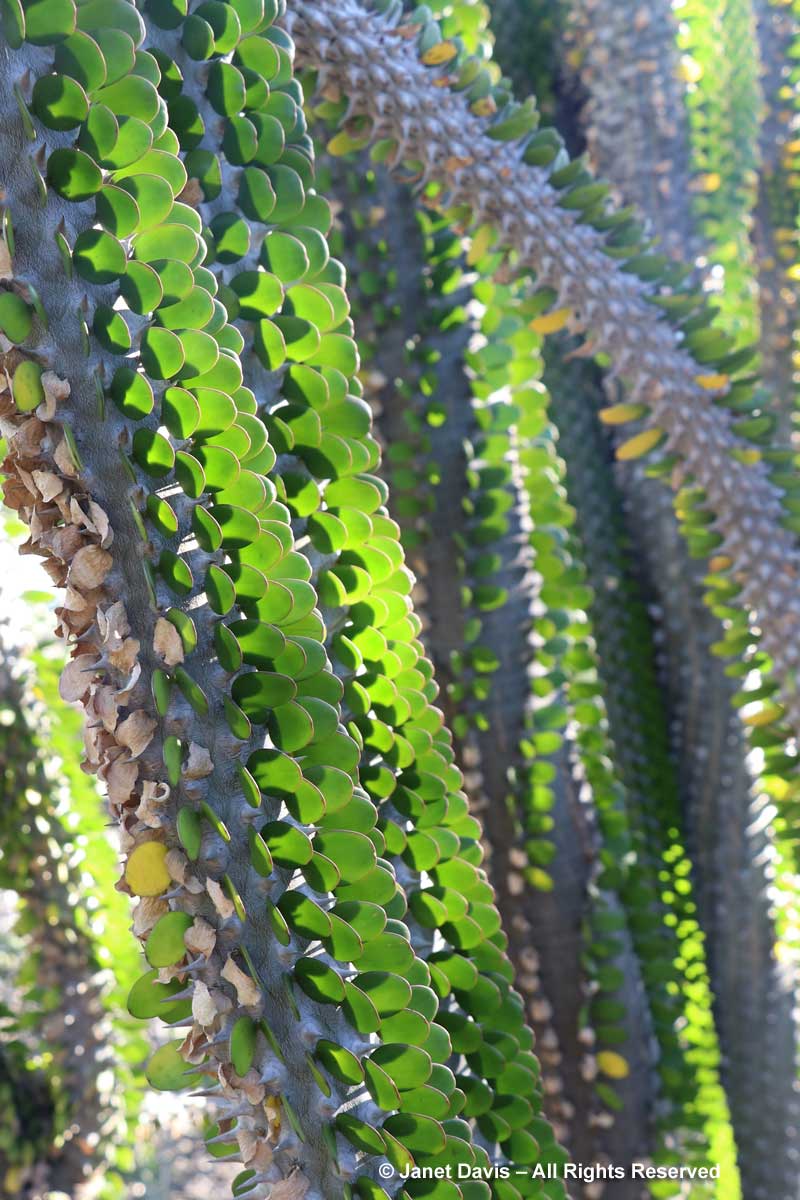
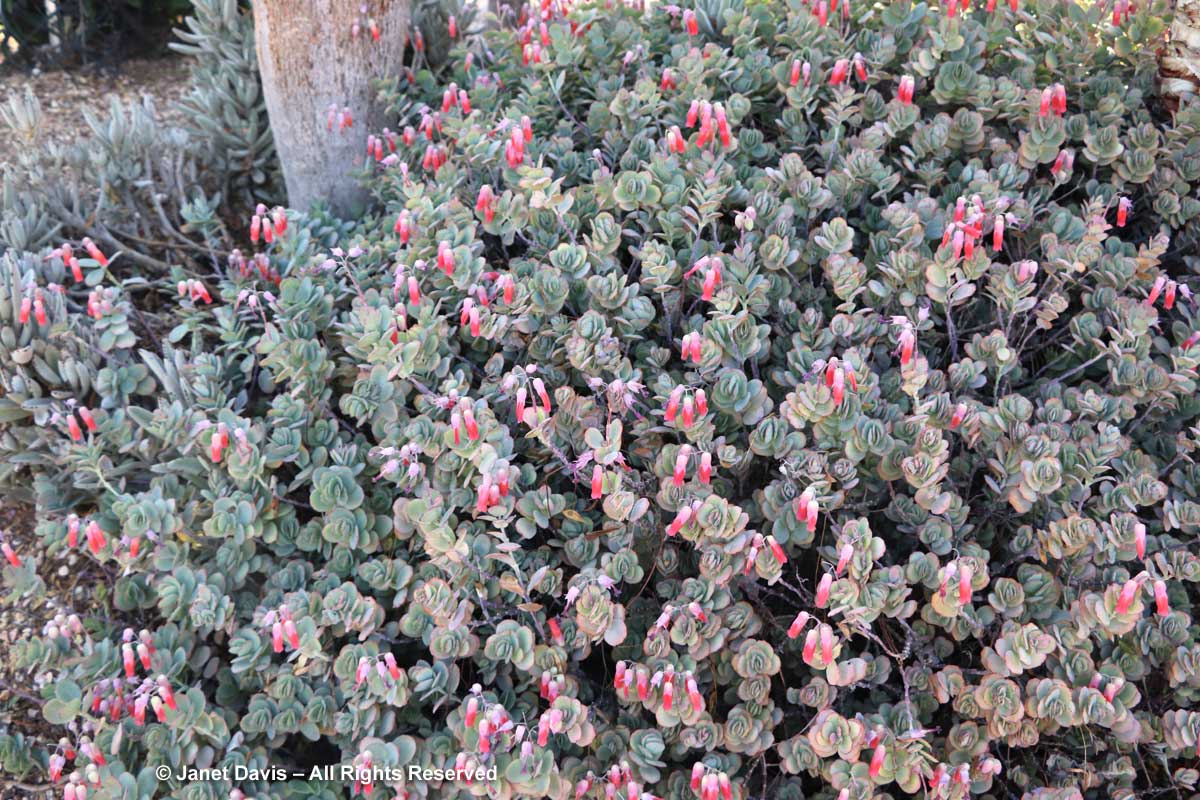
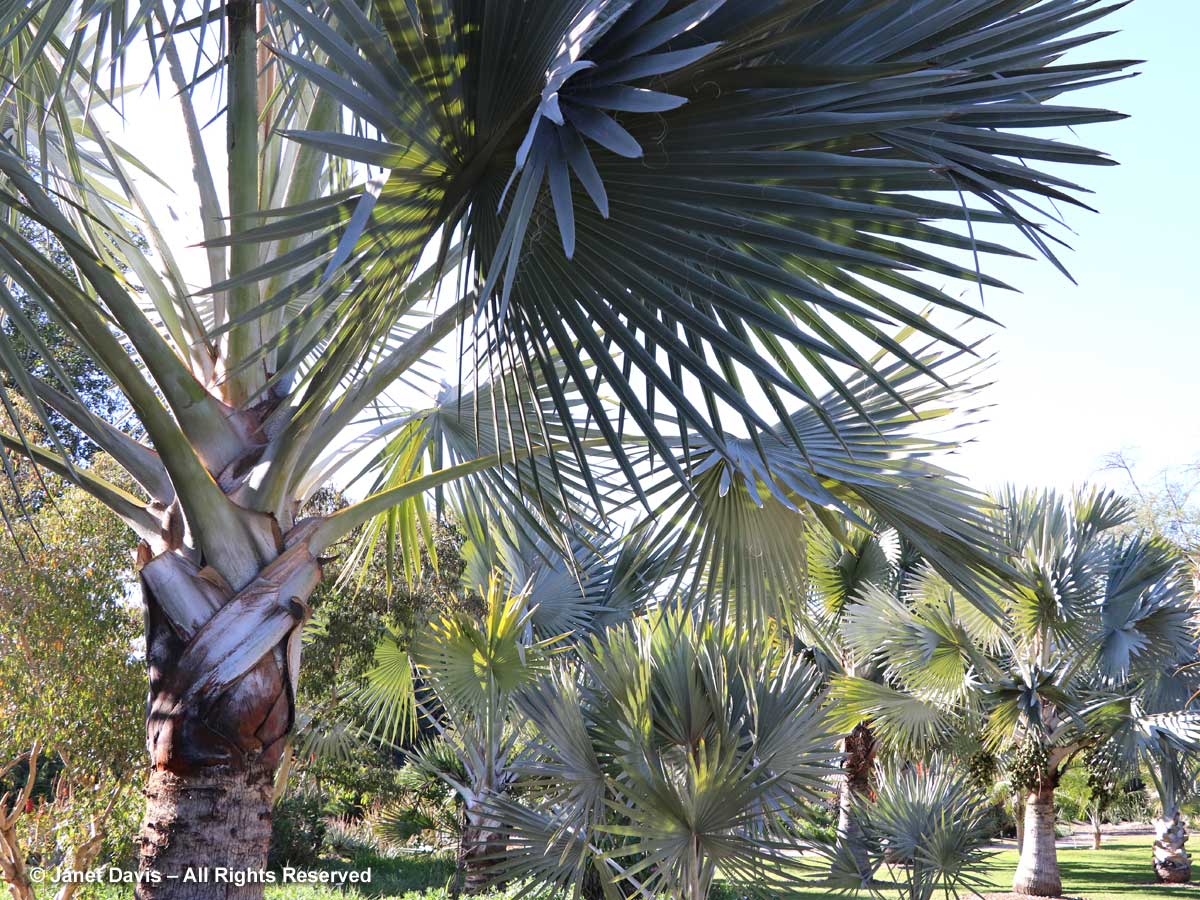
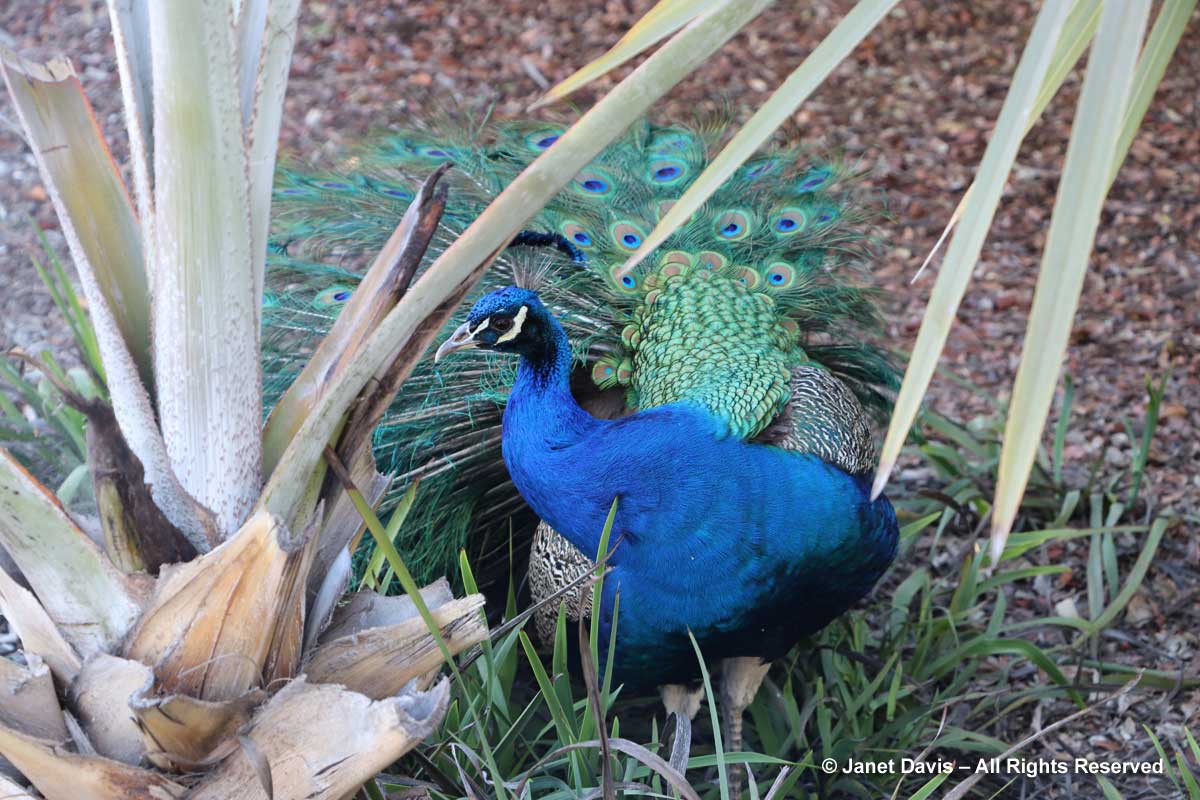
Janet,
What a beautiful series of pictures you presented with the gardens you visited.
With our rainy winter weather; it was delightful to look at color and beauty.
I am so pleased you continue to do your blog; I have learned so much from your pictures and comments.
Happy New Year to you and Doug; if you ever come our way you are more than welcome to stay with Jack/Jane or me. We do have some beautiful gardens in the area and I am sure you would find them interesting.
Love,
Bonnie
Dear Bonnie – so sorry to have missed this comment, which went into my spam filter. Thanks again, it was a pleasure writing about the gardens. I’ve even got a few left to do, some day….. And thanks for the invitation. x
Thanks for sharing. Next time I’m in Southern California I’m going to treat myself to a visit to the botanical gardens…I didn’t even know they existed.
I love your photos and accompanying narratives.
Thanks, Albertina. And be sure to visit The Huntington in Pasadena. Its succulent garden is amaaaazing.
You did a wonderful job covering the LA Arboretum. I learned a lot from your post – and I live in LA County. I was last there in late October, drawn by their fall plant sale. It was miserably hot and the garden wasn’t near its best. January is clearly a better time to visit! thanks for sharing your tour and your beautiful photos.
Thanks so much Kris! The African Garden is definitely where it’s at in January. Hope to see you in Denver…?